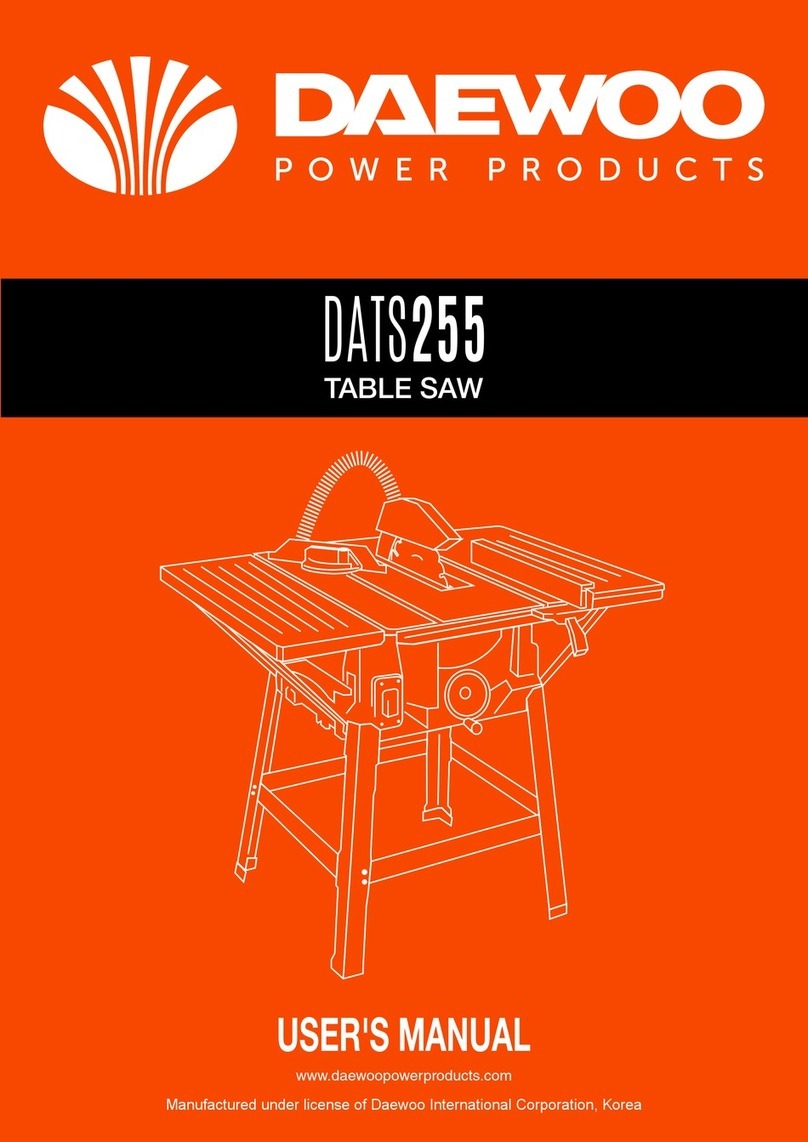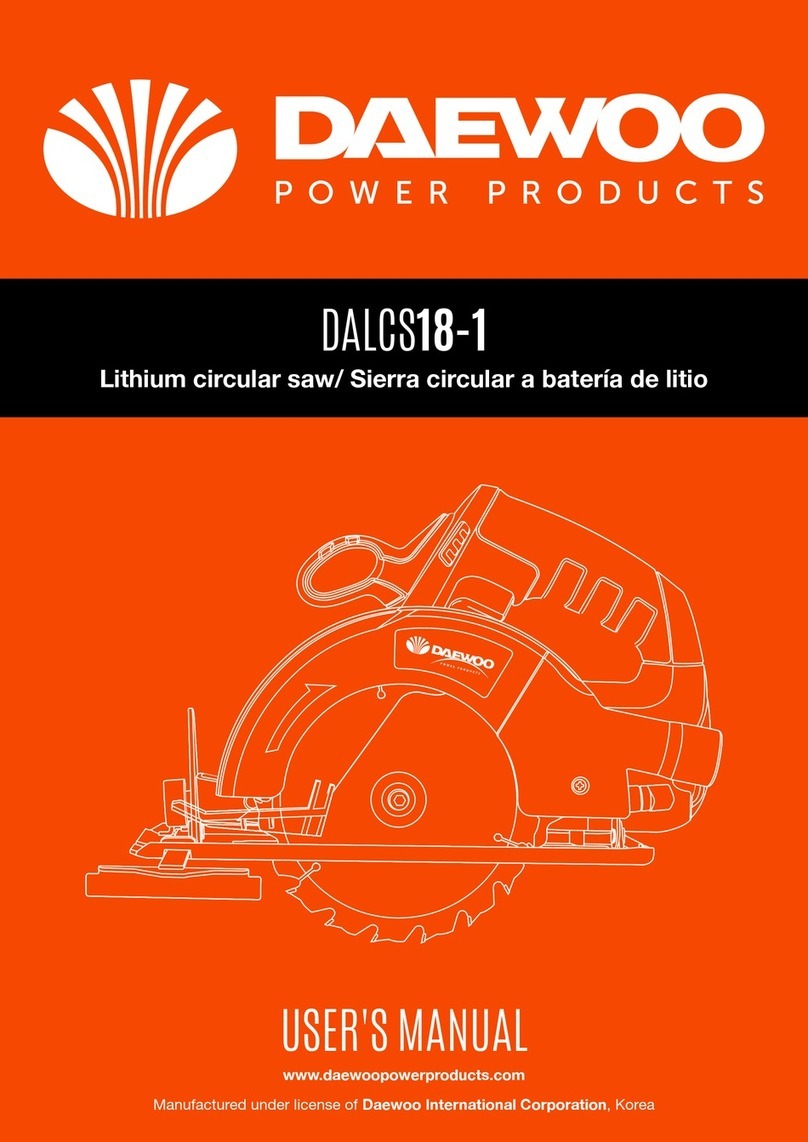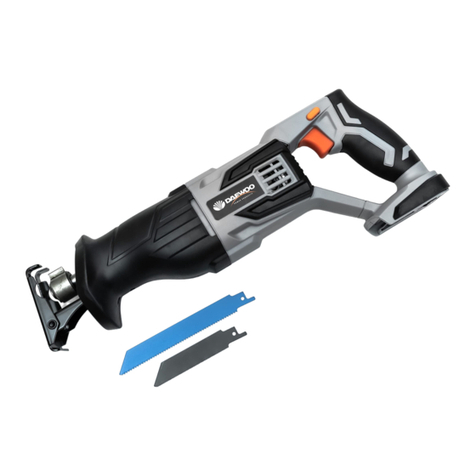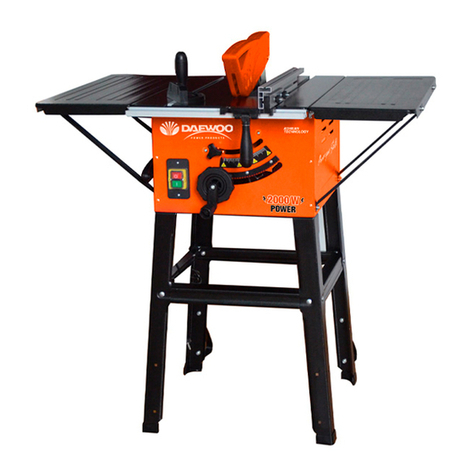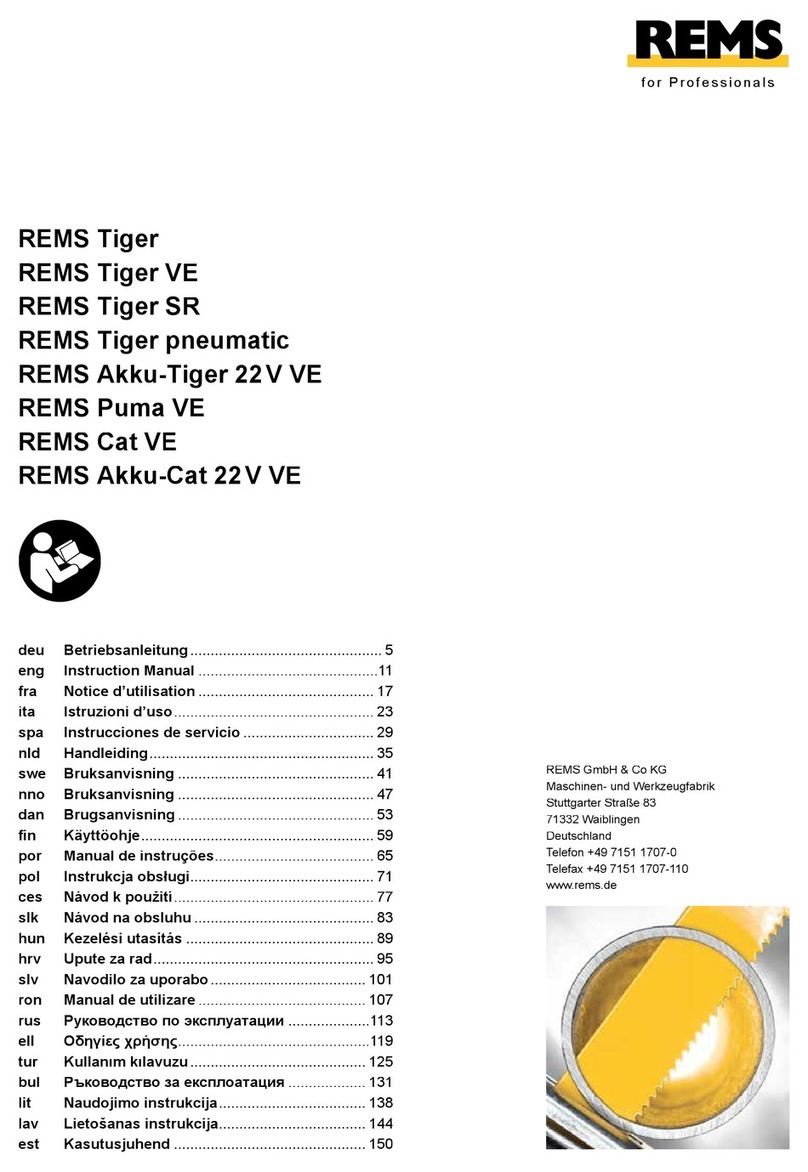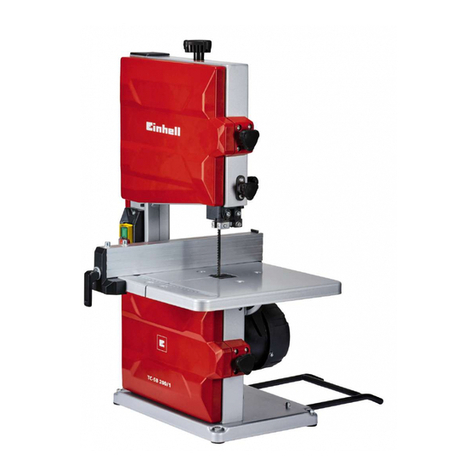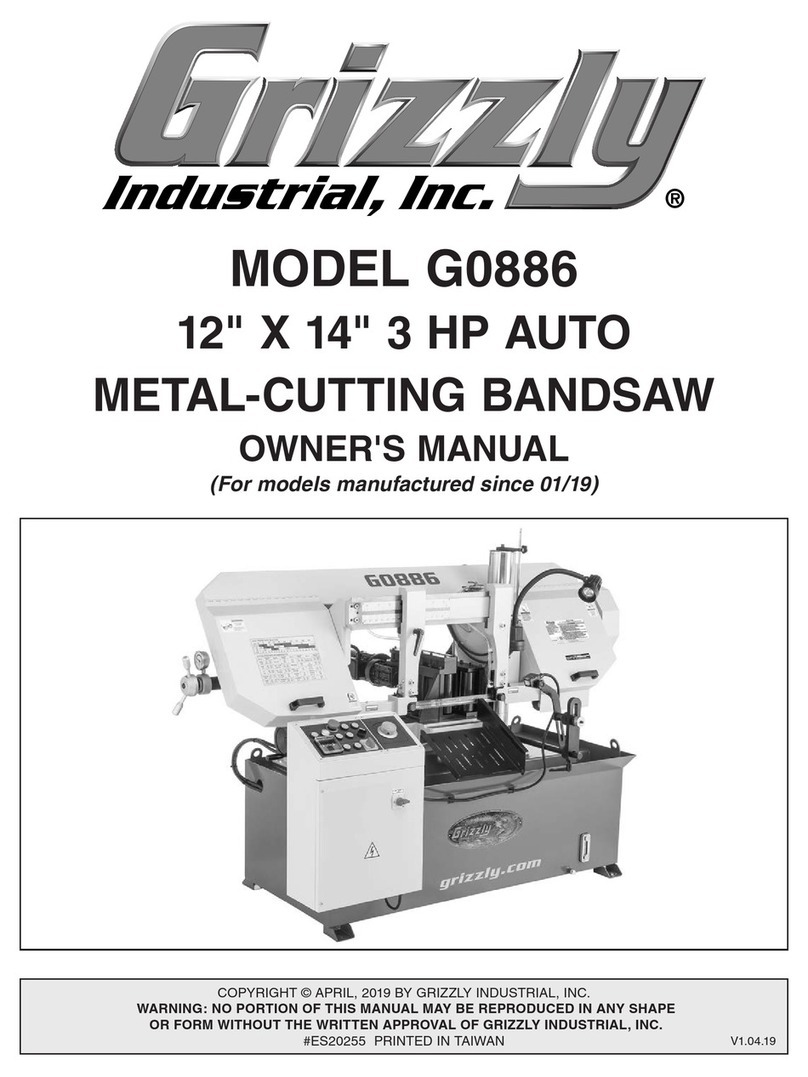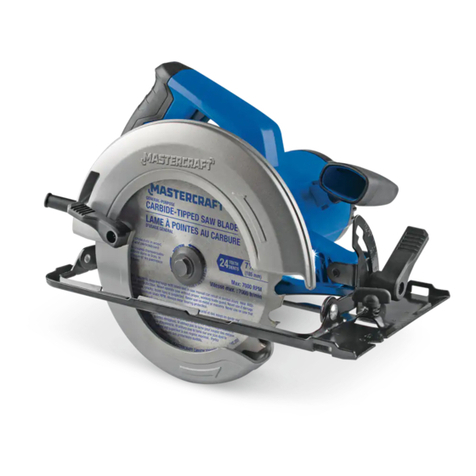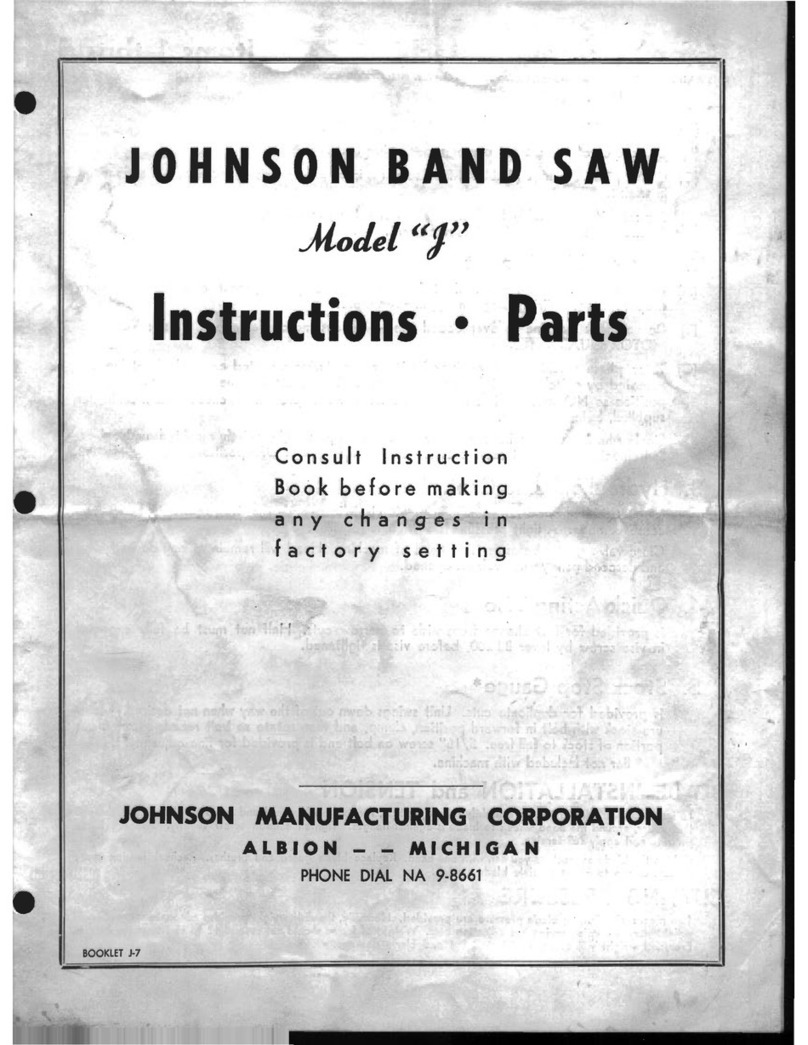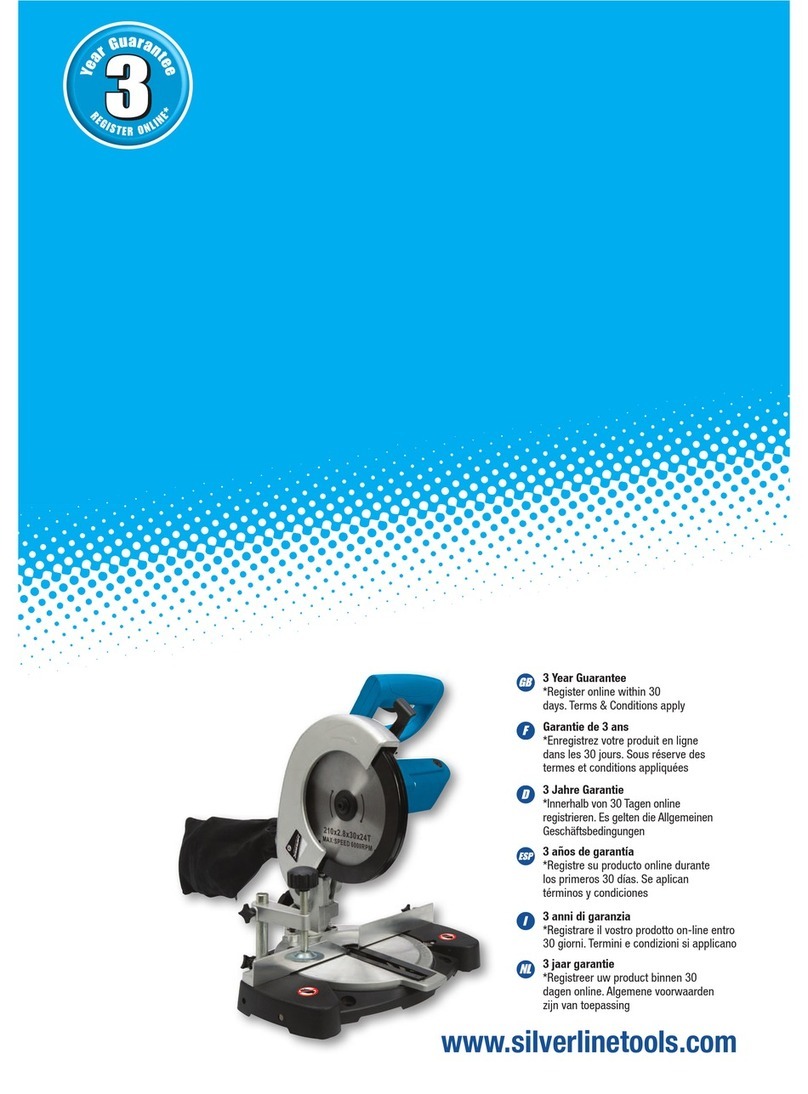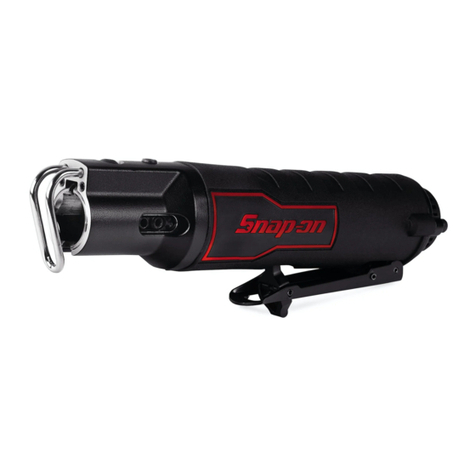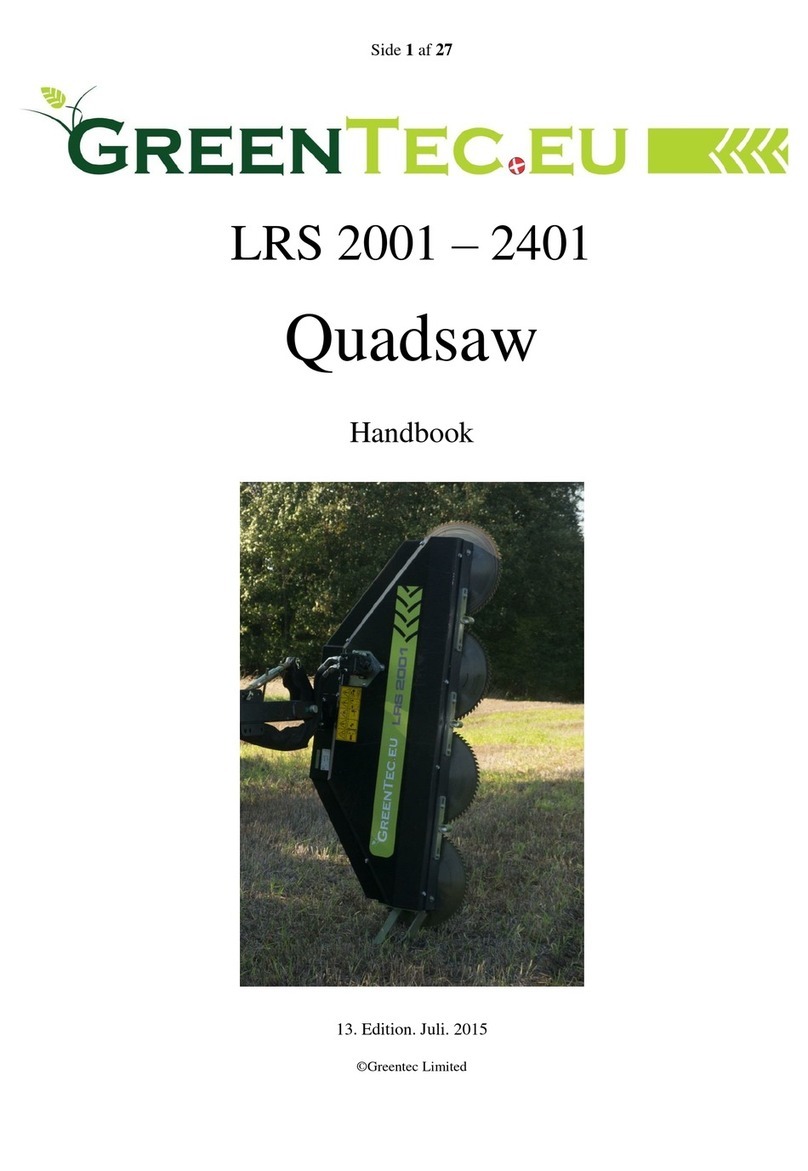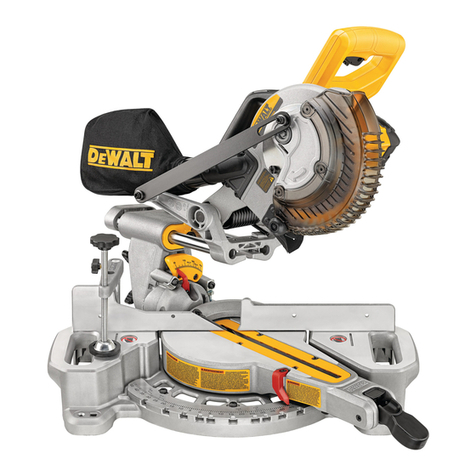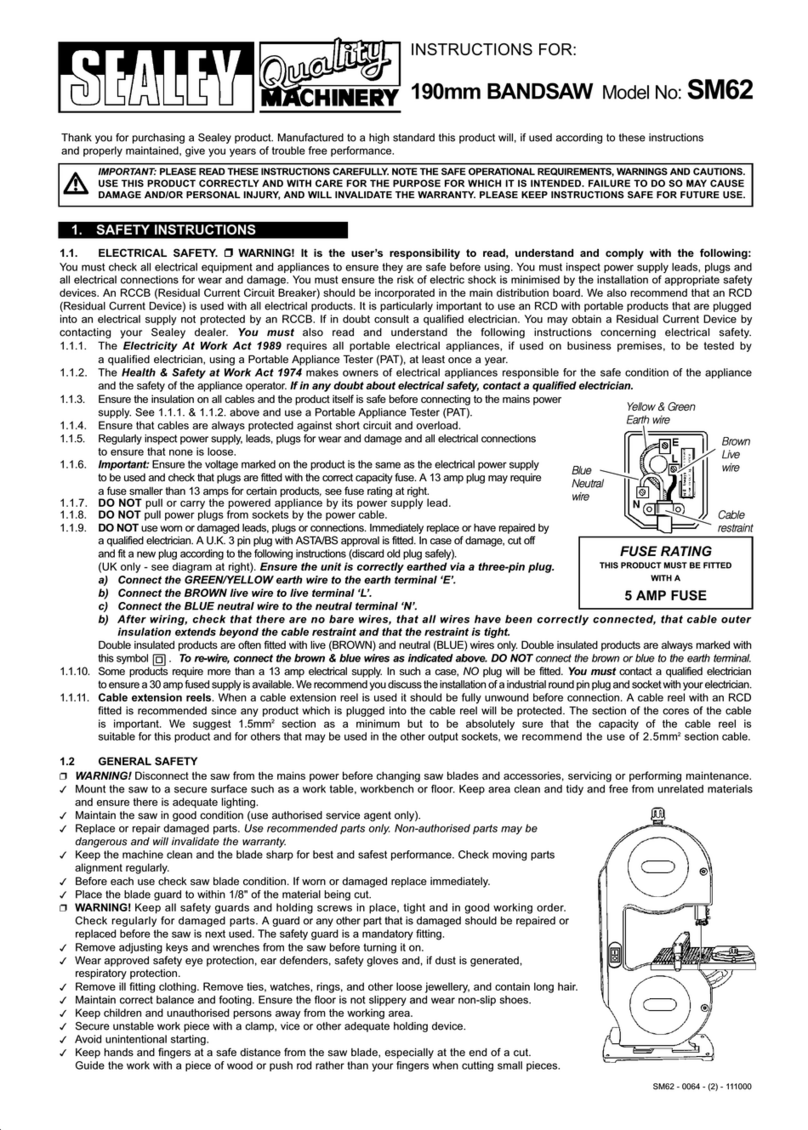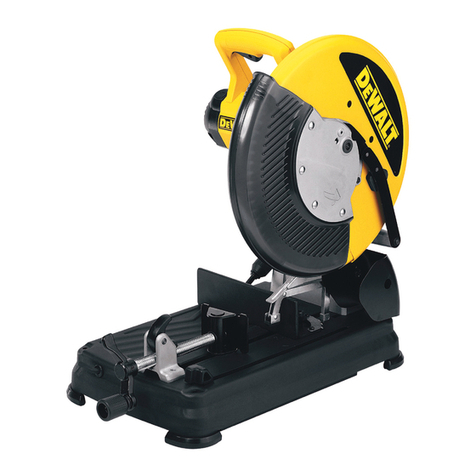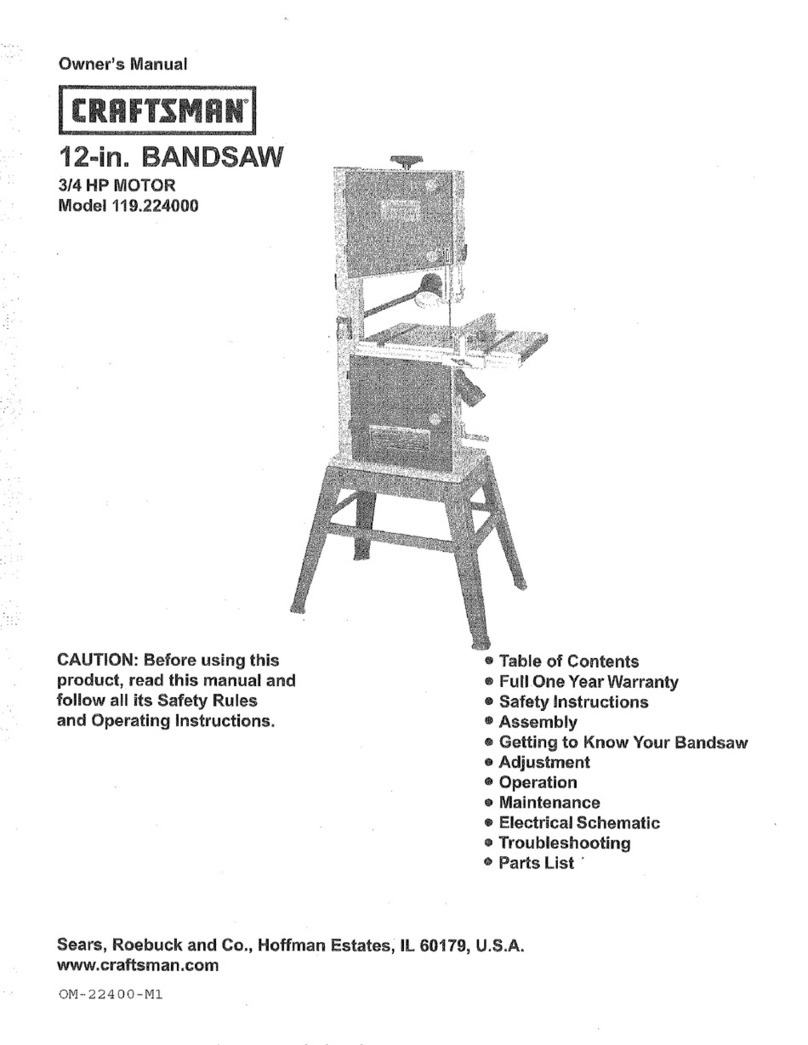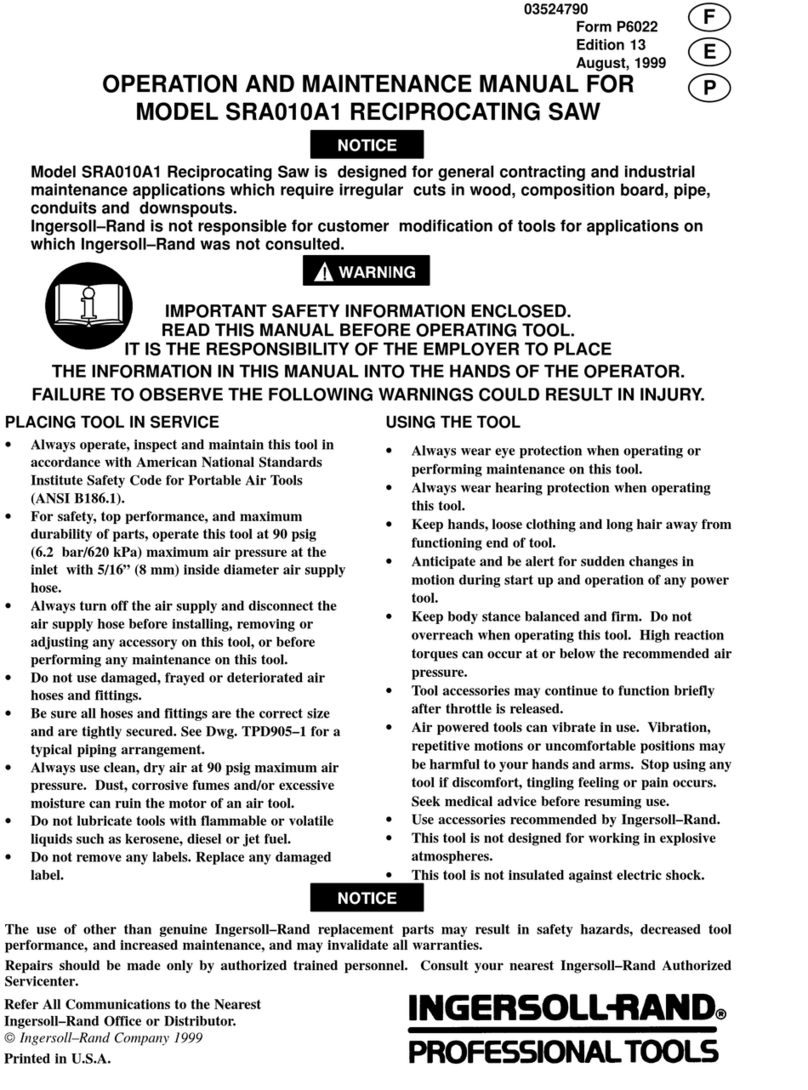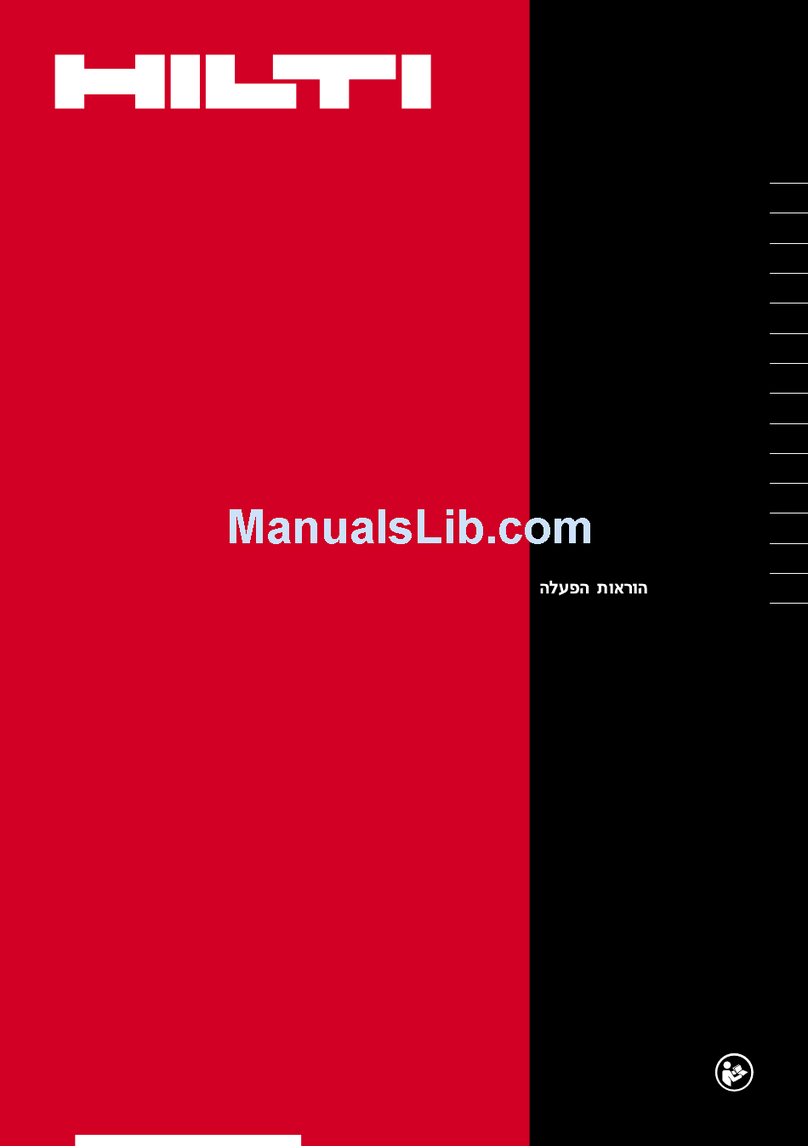Daewoo DALRC18-1 User manual

DALRC18-1
Lithium Reciprocating saw / Lítium akkumulátoros lengőfűrész
Manufactured under license of Daewoo International Corporation, Korea /
A koreai Daewoo International Corporation gyártási engedélye alapján gyártott készülék
www.daewoopowerproducts.com
USER'S MANUAL/ HASZNÁLATI UTASÍTÁS
1. GENERAL POWER TOOL SAFETY WARNINGS
WARNING: Read all
safety warnings and all instructions. Failure to follow the warnings and instructions may result in
electric shock, fire and/or serious injury. Save ali warnings and instructions for future reference. The
term "power too)" in the warnings refers to your mains-operated (corded) power tool or battery-ope-
rated (cordless) power tool.
1) Work area safety
a) Keep work area clean and well lit. Cluttered or dark areas invite accidents.
b) Do not operate power tooIs in explosive atmospheres, such as in the presence of flammable
liquids, gases or dust. Power tools create sparks which may ignite the dust or fumes.
c) Keep children and bystanders away while operating a power tool. Distractions can cause you to
lose control.
2) Electrical safety
a) Power tool plugs must match the outlet. Never modify the plug in any way. Do not use any adap-
ter plugs with earthed (grounded) power tools. Unmodified plugs and matching outlets will reduce
risk of electric shock.
b) Avoid body contaet with earthed or grounded surfaces, such as pipes, radiators, ranges and
refrigerators. There is an increased risk of electric shock if your body is earthed or grounded.
c) Do not expose power tools to rain or wet conditions. Water entering a power too! will increase the
risk of electric shock.
d) Do not abuse the cord. Never use the cord for carrying, pulling or unplugging the power too).
Keep cord away from heat, oil, sharp edges or moving parts. Damaged or entangled cords increase
the risk of electric shock.
e) When operating a power tool outdoors, use an extension cord suitable for outdoor use. Use of a
cord suitable far outdoor use reduces the risk of electric shock.
f) If operating a power tool in a damp location is unavoidable, use a residual current device (RCD)
protected supply. Use of an RCD reduces the risk of electric shock.
3) Personal safety
a) Stay alert, watch what you are doing and use common sense when operating a power tool. Do
not use a power tool while you are tired or under the influence of drugs, alcohol or medication. A
moment of inattention while operating power tools may result in serious personal injury.
b) Use personal protective equipment. Always wear eye protection. Protective equipment such as
dust mask, non-skid safety shoes, hard hat, or hearing protection used for appropriate conditions
will reduce personal injuries.
c) Prevent unintentional starting. Ensure the switch is in the off-position before connecting to power
source and/or battery pack, picking up or carrying the tool.
Carrying power tools with your finger on the switch or energizing power tools that have the switch
on invites accidents.
d) Remove any adjusting key or wrench before turning the power tool on. A wrench or a key left
attached to a rotating part of the power too! may result in personal injury.
e) Do not overreach. Keep proper footing and balance at ali times. This enables better control of the
power too! in unexpected situations.
f) Dress properly. Do not wear loose clothing or jewellery. Keep your hair, clothing and gloves away
from moving parts. Loase clothes , jewellery or long hair can be caught in moving parts.
g) If devices are provided for the connection of dust extraction and collection facilities, ensure these
are connected and properly used. Use of dust collection can reduce dust-related hazards.
4) Power tool use and care
a) Do not force the power tool. Use the correct power tool for your application. The correct power
too! will do the Job better and safer at the rafe for which it was designed.
b) Do not use the power too) if the switch does not turn it on and off. Any power tool that cannot be
controlled with the switch is dangerous and must be repaired.
c) Disconnect the plug from the power source and/or the battery pack from the power tool before
making any adjustments, changing accessories, or storing power tools. Such preventive safety
measures reduce the risk of starting the power tool accidentaly.
d) Store idle power tools out of the reach of children and do not allow persons unfamiliar with the
power tool or these instructions to operate the power tool. Power tools are dangerous in the hands
of untrained users.
e) Maintain power tools. Check for misalignment or binding of moving parts, breakage of parts and
any other condition that may affect the power tools operation. If damaged, have the power tool
repaired before use. Many accidents are caused by poorly maintained power tools.
f) Keep cutting tools sharp and clean. Properly maintained cutting tools with sharp cutting edges
are less likely to bind and are easier to control.
g) Use the power tool, accessories and tool bits etc. in accordance with these instructions, taking
into account the working conditions and the work to be performed. Use of the power tool for opera-
tions different from those intended could result in a hazardous situation.
5) Service
a) Have your power tool serviced by a qualified repair person using only identical replacement parts.
This will ensure that the safety of the power too/ is maintained.
2. SPECIFIC SAFETY RULES
a) Always holding at the insulated grip surface to avoid being electric shocked in case of cutting live
wires.
b) Do not stare at cutting blade. If blade was broken, it may cause injury to user.
c) Allow the too! to come to a complete stop before putting it down. A running tool will jerk when the
blade tip contacts any surface.
d) Always wear safety glasses or goggles. Normal prescription eye or sunglasses are not safety
glasses.
e) Do not cut oversized work pieces
f) Do not cut nails or screws unless you are usmg a blade specifically designed for this purpose,
inspect your material before cutting
g) Before switching on the tool, be sure the blade is not contacting the work piece.
h) Keep hands away from moving parts and on the top surface of the work piece. Do not place
hands below work piece while saw is operating.
i) Check your area for proper clearance before cutting. This will avoid cutting into your work bench,
the floor, etc.
3. FUNCTION DESCRIPTION
l. Switch button
2. Lock-ON button
3. Speed adjusting knob
4. Quick-release blade clamp
5. shoe
6. blade
7. Locking nut (downside)
ASSEMBLY
• Always check that the power supply corresponds to the voltage on the rating name plate.
• To avoid accidental start, check to make sure lock-ON button is not engaged prior to plugging in
too) and you finger is not touching the on/off switch button.
INSTALL THE BLADE
1. Unplug the power cord first
2. Rotate the Quick-release blade clamp(4) anticlockwise with hand
3. At the same time push blade (6) to the deepest positi on, then re lease the quick-release blade
clamp.
4. Make sure it is securely fastened.
WARNING! Before plugging in power cord, always pull on the blade to make sure it is securely
locked in the clamp. Failure to do so may result in serious injury.
OPERATION SWTICH ON AND OFF (Fig. 3)
1. Connect the plug to the power supply.
2. Grasp the switch button (1) to turn switch On.
3. Press down the lock-off button (2) can locked switch in ON positi on.
4. Grasp the switch button(l) again and release it, the saw will be switched off.
SPEED ADJUSTING KNOB (Fig.4)
The tool can be set at 6 positions. the " 1" position indicates the lowest speed and the " 6" position
indicates the highest speed, you can adju st different speed by turning the speed adjusting knob (3)
from " 1"to " 6" position. The operator may have to vary the speed to optimize cutting efficiency.
Lower speed: for cutting plastic, soft aluminum, sorne stainless steel.
High speed: for cutting aluminum. Mild steel, stainless steel ,various woods.
CUTTING
Clamp your work piece if it is portable, rest the front shoe of the saw on your work piece (be sure
the blade is not contacting the work piece) and start the saw, exerting enough pressure in the
direction of the cut to keep the shoe pressed firmly against the work piece at all times, Do not force
the cut or stall the saw bald. Don 't bend or twist the blade, Jet the too) and the blade cutting work
piece smoothly.
In general, coarser blades are for wood, plastics , and composites , and finer blades are for cut-
ting metal, chattering or vibration may indicate you need fine blade or higher speed, if the blade
overheats or clogs, it may indicate you need a coarser blade when they become dull, Dull blades
will produce poor results and may overheat the saw.
PLUNGE CUTTING
Clearly mark the line of cut, from a convenient starting point within the cut out area, place the tip of
the blade over that point with saw parallel to the line of cut, slowing lower the saw until the button
edge of the shoe rests on the work piece and the blade not touching the work piece, start the saw
and allow it to attain fu]] speed. With the saw resting on the shoe, slowly tilt the saw forward to
lower the blade onto the cut line. Continue this motion until the saw blade is perpendicular to the
work piece.
METAL CUTTING
Blades specifically designated for cutting metals must be used for this purpose. You may use light
oil as a coolant when cutting metal, this will prevent overheating of the blade, help the blade cut
faster, and promote longer blade life.
DEPTH OF CUT ADJUSTMENT
The front shoe can be adjusted to change the depth of cut of you reciprocating saw, To adjust the
depth of the cut, loasen the front shoe locking nut (7) by the provided wrench. Set your depth of
cut (Note: ideal depth of cut is 1 " deeper than material to be cut) then tighten the front shoe
locking nut securely.
4. TECHNICAL SPECIFICATIONS
Voltage: 220-240V
Frequency: 50Hz
Rated power: 18V
No load speed: 0-3000 spm
Max. Cutting capacity: Wood: 100mm; metal: 10mm
Sound level : LpA=82.2 dB (A); LwA= 93.2 dB(A)
Vibration: ah,B = 18,067 m²/s
ah,WB = 16,844 m²/s
5. CLEANING AND MAINTENANCE
The machine does not require any special maintenance. Regularly clean the ventilation slots.
Caution: Do not use cleaning agents to clean the plastic parts of the tool. A mild detergent on a
damp cloth is recommended. Water must never come into contact with the tool.
Meaning of crossed-out wheeled dustbind
Do not dispose of electrical appliances as unsorted municipal waste, use separate collection facili-
ties. Contact you local government for information regarding the collection systems available. If
electrical appliances are dis posed of in landfills or dumps, hazardous substances can leak into
the groundwater and get into the food chain, damaging your health and well-being.
When replacing old appliances with new ones, the retailer is legally obligated to take back your old
appliance for disposals at least free of charge

INDEX
1. GENERAL POWER TOOL SAFETY WARNINGS
.................................................................................. 2
2. SPECIFIC SAFETY RULES
.................................................................................................................... 3
3. FUNCTION DESCRIPTION
.................................................................................................................... 4
4. TECHNICAL SPECIFICATIONS
............................................................................................................. 6
5. CLEANING AND MAINTENANCE
......................................................................................................... 6
TARTALOM
1. ELEKTROMOS SZERSZÁMOKRA VONATKOZÓ ÁLTALÁNOS BIZTONSÁGI ELŐÍRÁSOK
............ 7
2. MEGHATÁROZOTT BIZTONSÁGI ELŐÍRÁSOK
................................................................................... 8
3. FUNKCIÓ LEÍRÁS
................................................................................................................................... 9
4. MŰSZAKI ADATOK
............................................................................................................................... 11
5. TISZTÍTÁS ÉS KARBANTARTÁS
......................................................................................................... 13
GARANCIA ................................................................................................................................................. 14
HU
EN
1
1. GENERAL POWER TOOL SAFETY WARNINGS
WARNING: Read all
safety warnings and all instructions. Failure to follow the warnings and instructions may result in
electric shock, fire and/or serious injury. Save ali warnings and instructions for future reference. The
term "power too)" in the warnings refers to your mains-operated (corded) power tool or battery-ope-
rated (cordless) power tool.
1) Work area safety
a) Keep work area clean and well lit. Cluttered or dark areas invite accidents.
b) Do not operate power tooIs in explosive atmospheres, such as in the presence of flammable
liquids, gases or dust. Power tools create sparks which may ignite the dust or fumes.
c) Keep children and bystanders away while operating a power tool. Distractions can cause you to
lose control.
2) Electrical safety
a) Power tool plugs must match the outlet. Never modify the plug in any way. Do not use any adap-
ter plugs with earthed (grounded) power tools. Unmodified plugs and matching outlets will reduce
risk of electric shock.
b) Avoid body contaet with earthed or grounded surfaces, such as pipes, radiators, ranges and
refrigerators. There is an increased risk of electric shock if your body is earthed or grounded.
c) Do not expose power tools to rain or wet conditions. Water entering a power too! will increase the
risk of electric shock.
d) Do not abuse the cord. Never use the cord for carrying, pulling or unplugging the power too).
Keep cord away from heat, oil, sharp edges or moving parts. Damaged or entangled cords increase
the risk of electric shock.
e) When operating a power tool outdoors, use an extension cord suitable for outdoor use. Use of a
cord suitable far outdoor use reduces the risk of electric shock.
f) If operating a power tool in a damp location is unavoidable, use a residual current device (RCD)
protected supply. Use of an RCD reduces the risk of electric shock.
3) Personal safety
a) Stay alert, watch what you are doing and use common sense when operating a power tool. Do
not use a power tool while you are tired or under the influence of drugs, alcohol or medication. A
moment of inattention while operating power tools may result in serious personal injury.
b) Use personal protective equipment. Always wear eye protection. Protective equipment such as
dust mask, non-skid safety shoes, hard hat, or hearing protection used for appropriate conditions
will reduce personal injuries.
c) Prevent unintentional starting. Ensure the switch is in the off-position before connecting to power
source and/or battery pack, picking up or carrying the tool.
Carrying power tools with your finger on the switch or energizing power tools that have the switch
on invites accidents.
d) Remove any adjusting key or wrench before turning the power tool on. A wrench or a key left
attached to a rotating part of the power too! may result in personal injury.
e) Do not overreach. Keep proper footing and balance at ali times. This enables better control of the
power too! in unexpected situations.
f) Dress properly. Do not wear loose clothing or jewellery. Keep your hair, clothing and gloves away
from moving parts. Loase clothes , jewellery or long hair can be caught in moving parts.
g) If devices are provided for the connection of dust extraction and collection facilities, ensure these
are connected and properly used. Use of dust collection can reduce dust-related hazards.
4) Power tool use and care
a) Do not force the power tool. Use the correct power tool for your application. The correct power
too! will do the Job better and safer at the rafe for which it was designed.
b) Do not use the power too) if the switch does not turn it on and off. Any power tool that cannot be
controlled with the switch is dangerous and must be repaired.
c) Disconnect the plug from the power source and/or the battery pack from the power tool before
making any adjustments, changing accessories, or storing power tools. Such preventive safety
measures reduce the risk of starting the power tool accidentaly.
d) Store idle power tools out of the reach of children and do not allow persons unfamiliar with the
power tool or these instructions to operate the power tool. Power tools are dangerous in the hands
of untrained users.
e) Maintain power tools. Check for misalignment or binding of moving parts, breakage of parts and
any other condition that may affect the power tools operation. If damaged, have the power tool
repaired before use. Many accidents are caused by poorly maintained power tools.
f) Keep cutting tools sharp and clean. Properly maintained cutting tools with sharp cutting edges
are less likely to bind and are easier to control.
g) Use the power tool, accessories and tool bits etc. in accordance with these instructions, taking
into account the working conditions and the work to be performed. Use of the power tool for opera-
tions different from those intended could result in a hazardous situation.
5) Service
a) Have your power tool serviced by a qualified repair person using only identical replacement parts.
This will ensure that the safety of the power too/ is maintained.
2. SPECIFIC SAFETY RULES
a) Always holding at the insulated grip surface to avoid being electric shocked in case of cutting live
wires.
b) Do not stare at cutting blade. If blade was broken, it may cause injury to user.
c) Allow the too! to come to a complete stop before putting it down. A running tool will jerk when the
blade tip contacts any surface.
d) Always wear safety glasses or goggles. Normal prescription eye or sunglasses are not safety
glasses.
e) Do not cut oversized work pieces
f) Do not cut nails or screws unless you are usmg a blade specifically designed for this purpose,
inspect your material before cutting
g) Before switching on the tool, be sure the blade is not contacting the work piece.
h) Keep hands away from moving parts and on the top surface of the work piece. Do not place
hands below work piece while saw is operating.
i) Check your area for proper clearance before cutting. This will avoid cutting into your work bench,
the floor, etc.
3. FUNCTION DESCRIPTION
l. Switch button
2. Lock-ON button
3. Speed adjusting knob
4. Quick-release blade clamp
5. shoe
6. blade
7. Locking nut (downside)
ASSEMBLY
• Always check that the power supply corresponds to the voltage on the rating name plate.
• To avoid accidental start, check to make sure lock-ON button is not engaged prior to plugging in
too) and you finger is not touching the on/off switch button.
INSTALL THE BLADE
1. Unplug the power cord first
2. Rotate the Quick-release blade clamp(4) anticlockwise with hand
3. At the same time push blade (6) to the deepest positi on, then re lease the quick-release blade
clamp.
4. Make sure it is securely fastened.
WARNING! Before plugging in power cord, always pull on the blade to make sure it is securely
locked in the clamp. Failure to do so may result in serious injury.
OPERATION SWTICH ON AND OFF (Fig. 3)
1. Connect the plug to the power supply.
2. Grasp the switch button (1) to turn switch On.
3. Press down the lock-off button (2) can locked switch in ON positi on.
4. Grasp the switch button(l) again and release it, the saw will be switched off.
SPEED ADJUSTING KNOB (Fig.4)
The tool can be set at 6 positions. the " 1" position indicates the lowest speed and the " 6" position
indicates the highest speed, you can adju st different speed by turning the speed adjusting knob (3)
from " 1"to " 6" position. The operator may have to vary the speed to optimize cutting efficiency.
Lower speed: for cutting plastic, soft aluminum, sorne stainless steel.
High speed: for cutting aluminum. Mild steel, stainless steel ,various woods.
CUTTING
Clamp your work piece if it is portable, rest the front shoe of the saw on your work piece (be sure
the blade is not contacting the work piece) and start the saw, exerting enough pressure in the
direction of the cut to keep the shoe pressed firmly against the work piece at all times, Do not force
the cut or stall the saw bald. Don 't bend or twist the blade, Jet the too) and the blade cutting work
piece smoothly.
In general, coarser blades are for wood, plastics , and composites , and finer blades are for cut-
ting metal, chattering or vibration may indicate you need fine blade or higher speed, if the blade
overheats or clogs, it may indicate you need a coarser blade when they become dull, Dull blades
will produce poor results and may overheat the saw.
PLUNGE CUTTING
Clearly mark the line of cut, from a convenient starting point within the cut out area, place the tip of
the blade over that point with saw parallel to the line of cut, slowing lower the saw until the button
edge of the shoe rests on the work piece and the blade not touching the work piece, start the saw
and allow it to attain fu]] speed. With the saw resting on the shoe, slowly tilt the saw forward to
lower the blade onto the cut line. Continue this motion until the saw blade is perpendicular to the
work piece.
METAL CUTTING
Blades specifically designated for cutting metals must be used for this purpose. You may use light
oil as a coolant when cutting metal, this will prevent overheating of the blade, help the blade cut
faster, and promote longer blade life.
DEPTH OF CUT ADJUSTMENT
The front shoe can be adjusted to change the depth of cut of you reciprocating saw, To adjust the
depth of the cut, loasen the front shoe locking nut (7) by the provided wrench. Set your depth of
cut (Note: ideal depth of cut is 1 " deeper than material to be cut) then tighten the front shoe
locking nut securely.
4. TECHNICAL SPECIFICATIONS
Voltage: 220-240V
Frequency: 50Hz
Rated power: 18V
No load speed: 0-3000 spm
Max. Cutting capacity: Wood: 100mm; metal: 10mm
Sound level : LpA=82.2 dB (A); LwA= 93.2 dB(A)
Vibration: ah,B = 18,067 m²/s
ah,WB = 16,844 m²/s
5. CLEANING AND MAINTENANCE
The machine does not require any special maintenance. Regularly clean the ventilation slots.
Caution: Do not use cleaning agents to clean the plastic parts of the tool. A mild detergent on a
damp cloth is recommended. Water must never come into contact with the tool.
Meaning of crossed-out wheeled dustbind
Do not dispose of electrical appliances as unsorted municipal waste, use separate collection facili-
ties. Contact you local government for information regarding the collection systems available. If
electrical appliances are dis posed of in landfills or dumps, hazardous substances can leak into
the groundwater and get into the food chain, damaging your health and well-being.
When replacing old appliances with new ones, the retailer is legally obligated to take back your old
appliance for disposals at least free of charge

2
1. GENERAL POWER TOOL SAFETY WARNINGS
WARNING: Read all
safety warnings and all instructions. Failure to follow the warnings and instructions may result in
electric shock, fire and/or serious injury. Save ali warnings and instructions for future reference. The
term "power too)" in the warnings refers to your mains-operated (corded) power tool or battery-ope-
rated (cordless) power tool.
1) Work area safety
a) Keep work area clean and well lit. Cluttered or dark areas invite accidents.
b) Do not operate power tooIs in explosive atmospheres, such as in the presence of flammable
liquids, gases or dust. Power tools create sparks which may ignite the dust or fumes.
c) Keep children and bystanders away while operating a power tool. Distractions can cause you to
lose control.
2) Electrical safety
a) Power tool plugs must match the outlet. Never modify the plug in any way. Do not use any adap-
ter plugs with earthed (grounded) power tools. Unmodified plugs and matching outlets will reduce
risk of electric shock.
b) Avoid body contaet with earthed or grounded surfaces, such as pipes, radiators, ranges and
refrigerators. There is an increased risk of electric shock if your body is earthed or grounded.
c) Do not expose power tools to rain or wet conditions. Water entering a power too! will increase the
risk of electric shock.
d) Do not abuse the cord. Never use the cord for carrying, pulling or unplugging the power too).
Keep cord away from heat, oil, sharp edges or moving parts. Damaged or entangled cords increase
the risk of electric shock.
e) When operating a power tool outdoors, use an extension cord suitable for outdoor use. Use of a
cord suitable far outdoor use reduces the risk of electric shock.
f) If operating a power tool in a damp location is unavoidable, use a residual current device (RCD)
protected supply. Use of an RCD reduces the risk of electric shock.
3) Personal safety
a) Stay alert, watch what you are doing and use common sense when operating a power tool. Do
not use a power tool while you are tired or under the influence of drugs, alcohol or medication. A
moment of inattention while operating power tools may result in serious personal injury.
b) Use personal protective equipment. Always wear eye protection. Protective equipment such as
dust mask, non-skid safety shoes, hard hat, or hearing protection used for appropriate conditions
will reduce personal injuries.
c) Prevent unintentional starting. Ensure the switch is in the off-position before connecting to power
source and/or battery pack, picking up or carrying the tool.
Carrying power tools with your finger on the switch or energizing power tools that have the switch
on invites accidents.
d) Remove any adjusting key or wrench before turning the power tool on. A wrench or a key left
attached to a rotating part of the power too! may result in personal injury.
e) Do not overreach. Keep proper footing and balance at ali times. This enables better control of the
power too! in unexpected situations.
f) Dress properly. Do not wear loose clothing or jewellery. Keep your hair, clothing and gloves away
from moving parts. Loase clothes , jewellery or long hair can be caught in moving parts.
g) If devices are provided for the connection of dust extraction and collection facilities, ensure these
are connected and properly used. Use of dust collection can reduce dust-related hazards.
4) Power tool use and care
a) Do not force the power tool. Use the correct power tool for your application. The correct power
too! will do the Job better and safer at the rafe for which it was designed.
b) Do not use the power too) if the switch does not turn it on and off. Any power tool that cannot be
controlled with the switch is dangerous and must be repaired.
c) Disconnect the plug from the power source and/or the battery pack from the power tool before
making any adjustments, changing accessories, or storing power tools. Such preventive safety
measures reduce the risk of starting the power tool accidentaly.
d) Store idle power tools out of the reach of children and do not allow persons unfamiliar with the
power tool or these instructions to operate the power tool. Power tools are dangerous in the hands
of untrained users.
e) Maintain power tools. Check for misalignment or binding of moving parts, breakage of parts and
any other condition that may affect the power tools operation. If damaged, have the power tool
repaired before use. Many accidents are caused by poorly maintained power tools.
f) Keep cutting tools sharp and clean. Properly maintained cutting tools with sharp cutting edges
are less likely to bind and are easier to control.
g) Use the power tool, accessories and tool bits etc. in accordance with these instructions, taking
into account the working conditions and the work to be performed. Use of the power tool for opera-
tions different from those intended could result in a hazardous situation.
5) Service
a) Have your power tool serviced by a qualified repair person using only identical replacement parts.
This will ensure that the safety of the power too/ is maintained.
2. SPECIFIC SAFETY RULES
a) Always holding at the insulated grip surface to avoid being electric shocked in case of cutting live
wires.
b) Do not stare at cutting blade. If blade was broken, it may cause injury to user.
c) Allow the too! to come to a complete stop before putting it down. A running tool will jerk when the
blade tip contacts any surface.
d) Always wear safety glasses or goggles. Normal prescription eye or sunglasses are not safety
glasses.
e) Do not cut oversized work pieces
f) Do not cut nails or screws unless you are usmg a blade specifically designed for this purpose,
inspect your material before cutting
g) Before switching on the tool, be sure the blade is not contacting the work piece.
h) Keep hands away from moving parts and on the top surface of the work piece. Do not place
hands below work piece while saw is operating.
i) Check your area for proper clearance before cutting. This will avoid cutting into your work bench,
the floor, etc.
3. FUNCTION DESCRIPTION
l. Switch button
2. Lock-ON button
3. Speed adjusting knob
4. Quick-release blade clamp
5. shoe
6. blade
7. Locking nut (downside)
ASSEMBLY
• Always check that the power supply corresponds to the voltage on the rating name plate.
• To avoid accidental start, check to make sure lock-ON button is not engaged prior to plugging in
too) and you finger is not touching the on/off switch button.
INSTALL THE BLADE
1. Unplug the power cord first
2. Rotate the Quick-release blade clamp(4) anticlockwise with hand
3. At the same time push blade (6) to the deepest positi on, then re lease the quick-release blade
clamp.
4. Make sure it is securely fastened.
WARNING! Before plugging in power cord, always pull on the blade to make sure it is securely
locked in the clamp. Failure to do so may result in serious injury.
OPERATION SWTICH ON AND OFF (Fig. 3)
1. Connect the plug to the power supply.
2. Grasp the switch button (1) to turn switch On.
3. Press down the lock-off button (2) can locked switch in ON positi on.
4. Grasp the switch button(l) again and release it, the saw will be switched off.
SPEED ADJUSTING KNOB (Fig.4)
The tool can be set at 6 positions. the " 1" position indicates the lowest speed and the " 6" position
indicates the highest speed, you can adju st different speed by turning the speed adjusting knob (3)
from " 1"to " 6" position. The operator may have to vary the speed to optimize cutting efficiency.
Lower speed: for cutting plastic, soft aluminum, sorne stainless steel.
High speed: for cutting aluminum. Mild steel, stainless steel ,various woods.
CUTTING
Clamp your work piece if it is portable, rest the front shoe of the saw on your work piece (be sure
the blade is not contacting the work piece) and start the saw, exerting enough pressure in the
direction of the cut to keep the shoe pressed firmly against the work piece at all times, Do not force
the cut or stall the saw bald. Don 't bend or twist the blade, Jet the too) and the blade cutting work
piece smoothly.
In general, coarser blades are for wood, plastics , and composites , and finer blades are for cut-
ting metal, chattering or vibration may indicate you need fine blade or higher speed, if the blade
overheats or clogs, it may indicate you need a coarser blade when they become dull, Dull blades
will produce poor results and may overheat the saw.
PLUNGE CUTTING
Clearly mark the line of cut, from a convenient starting point within the cut out area, place the tip of
the blade over that point with saw parallel to the line of cut, slowing lower the saw until the button
edge of the shoe rests on the work piece and the blade not touching the work piece, start the saw
and allow it to attain fu]] speed. With the saw resting on the shoe, slowly tilt the saw forward to
lower the blade onto the cut line. Continue this motion until the saw blade is perpendicular to the
work piece.
METAL CUTTING
Blades specifically designated for cutting metals must be used for this purpose. You may use light
oil as a coolant when cutting metal, this will prevent overheating of the blade, help the blade cut
faster, and promote longer blade life.
DEPTH OF CUT ADJUSTMENT
The front shoe can be adjusted to change the depth of cut of you reciprocating saw, To adjust the
depth of the cut, loasen the front shoe locking nut (7) by the provided wrench. Set your depth of
cut (Note: ideal depth of cut is 1 " deeper than material to be cut) then tighten the front shoe
locking nut securely.
4. TECHNICAL SPECIFICATIONS
Voltage: 220-240V
Frequency: 50Hz
Rated power: 18V
No load speed: 0-3000 spm
Max. Cutting capacity: Wood: 100mm; metal: 10mm
Sound level : LpA=82.2 dB (A); LwA= 93.2 dB(A)
Vibration: ah,B = 18,067 m²/s
ah,WB = 16,844 m²/s
5. CLEANING AND MAINTENANCE
The machine does not require any special maintenance. Regularly clean the ventilation slots.
Caution: Do not use cleaning agents to clean the plastic parts of the tool. A mild detergent on a
damp cloth is recommended. Water must never come into contact with the tool.
Meaning of crossed-out wheeled dustbind
Do not dispose of electrical appliances as unsorted municipal waste, use separate collection facili-
ties. Contact you local government for information regarding the collection systems available. If
electrical appliances are dis posed of in landfills or dumps, hazardous substances can leak into
the groundwater and get into the food chain, damaging your health and well-being.
When replacing old appliances with new ones, the retailer is legally obligated to take back your old
appliance for disposals at least free of charge
EN

3
1. GENERAL POWER TOOL SAFETY WARNINGS
WARNING: Read all
safety warnings and all instructions. Failure to follow the warnings and instructions may result in
electric shock, fire and/or serious injury. Save ali warnings and instructions for future reference. The
term "power too)" in the warnings refers to your mains-operated (corded) power tool or battery-ope-
rated (cordless) power tool.
1) Work area safety
a) Keep work area clean and well lit. Cluttered or dark areas invite accidents.
b) Do not operate power tooIs in explosive atmospheres, such as in the presence of flammable
liquids, gases or dust. Power tools create sparks which may ignite the dust or fumes.
c) Keep children and bystanders away while operating a power tool. Distractions can cause you to
lose control.
2) Electrical safety
a) Power tool plugs must match the outlet. Never modify the plug in any way. Do not use any adap-
ter plugs with earthed (grounded) power tools. Unmodified plugs and matching outlets will reduce
risk of electric shock.
b) Avoid body contaet with earthed or grounded surfaces, such as pipes, radiators, ranges and
refrigerators. There is an increased risk of electric shock if your body is earthed or grounded.
c) Do not expose power tools to rain or wet conditions. Water entering a power too! will increase the
risk of electric shock.
d) Do not abuse the cord. Never use the cord for carrying, pulling or unplugging the power too).
Keep cord away from heat, oil, sharp edges or moving parts. Damaged or entangled cords increase
the risk of electric shock.
e) When operating a power tool outdoors, use an extension cord suitable for outdoor use. Use of a
cord suitable far outdoor use reduces the risk of electric shock.
f) If operating a power tool in a damp location is unavoidable, use a residual current device (RCD)
protected supply. Use of an RCD reduces the risk of electric shock.
3) Personal safety
a) Stay alert, watch what you are doing and use common sense when operating a power tool. Do
not use a power tool while you are tired or under the influence of drugs, alcohol or medication. A
moment of inattention while operating power tools may result in serious personal injury.
b) Use personal protective equipment. Always wear eye protection. Protective equipment such as
dust mask, non-skid safety shoes, hard hat, or hearing protection used for appropriate conditions
will reduce personal injuries.
c) Prevent unintentional starting. Ensure the switch is in the off-position before connecting to power
source and/or battery pack, picking up or carrying the tool.
Carrying power tools with your finger on the switch or energizing power tools that have the switch
on invites accidents.
d) Remove any adjusting key or wrench before turning the power tool on. A wrench or a key left
attached to a rotating part of the power too! may result in personal injury.
e) Do not overreach. Keep proper footing and balance at ali times. This enables better control of the
power too! in unexpected situations.
f) Dress properly. Do not wear loose clothing or jewellery. Keep your hair, clothing and gloves away
from moving parts. Loase clothes , jewellery or long hair can be caught in moving parts.
g) If devices are provided for the connection of dust extraction and collection facilities, ensure these
are connected and properly used. Use of dust collection can reduce dust-related hazards.
4) Power tool use and care
a) Do not force the power tool. Use the correct power tool for your application. The correct power
too! will do the Job better and safer at the rafe for which it was designed.
b) Do not use the power too) if the switch does not turn it on and off. Any power tool that cannot be
controlled with the switch is dangerous and must be repaired.
c) Disconnect the plug from the power source and/or the battery pack from the power tool before
making any adjustments, changing accessories, or storing power tools. Such preventive safety
measures reduce the risk of starting the power tool accidentaly.
d) Store idle power tools out of the reach of children and do not allow persons unfamiliar with the
power tool or these instructions to operate the power tool. Power tools are dangerous in the hands
of untrained users.
e) Maintain power tools. Check for misalignment or binding of moving parts, breakage of parts and
any other condition that may affect the power tools operation. If damaged, have the power tool
repaired before use. Many accidents are caused by poorly maintained power tools.
f) Keep cutting tools sharp and clean. Properly maintained cutting tools with sharp cutting edges
are less likely to bind and are easier to control.
g) Use the power tool, accessories and tool bits etc. in accordance with these instructions, taking
into account the working conditions and the work to be performed. Use of the power tool for opera-
tions different from those intended could result in a hazardous situation.
5) Service
a) Have your power tool serviced by a qualified repair person using only identical replacement parts.
This will ensure that the safety of the power too/ is maintained.
2. SPECIFIC SAFETY RULES
a) Always holding at the insulated grip surface to avoid being electric shocked in case of cutting live
wires.
b) Do not stare at cutting blade. If blade was broken, it may cause injury to user.
c) Allow the too! to come to a complete stop before putting it down. A running tool will jerk when the
blade tip contacts any surface.
d) Always wear safety glasses or goggles. Normal prescription eye or sunglasses are not safety
glasses.
e) Do not cut oversized work pieces
f) Do not cut nails or screws unless you are usmg a blade specifically designed for this purpose,
inspect your material before cutting
g) Before switching on the tool, be sure the blade is not contacting the work piece.
h) Keep hands away from moving parts and on the top surface of the work piece. Do not place
hands below work piece while saw is operating.
i) Check your area for proper clearance before cutting. This will avoid cutting into your work bench,
the floor, etc.
3. FUNCTION DESCRIPTION
l. Switch button
2. Lock-ON button
3. Speed adjusting knob
4. Quick-release blade clamp
5. shoe
6. blade
7. Locking nut (downside)
ASSEMBLY
• Always check that the power supply corresponds to the voltage on the rating name plate.
• To avoid accidental start, check to make sure lock-ON button is not engaged prior to plugging in
too) and you finger is not touching the on/off switch button.
INSTALL THE BLADE
1. Unplug the power cord first
2. Rotate the Quick-release blade clamp(4) anticlockwise with hand
3. At the same time push blade (6) to the deepest positi on, then re lease the quick-release blade
clamp.
4. Make sure it is securely fastened.
WARNING! Before plugging in power cord, always pull on the blade to make sure it is securely
locked in the clamp. Failure to do so may result in serious injury.
OPERATION SWTICH ON AND OFF (Fig. 3)
1. Connect the plug to the power supply.
2. Grasp the switch button (1) to turn switch On.
3. Press down the lock-off button (2) can locked switch in ON positi on.
4. Grasp the switch button(l) again and release it, the saw will be switched off.
SPEED ADJUSTING KNOB (Fig.4)
The tool can be set at 6 positions. the " 1" position indicates the lowest speed and the " 6" position
indicates the highest speed, you can adju st different speed by turning the speed adjusting knob (3)
from " 1"to " 6" position. The operator may have to vary the speed to optimize cutting efficiency.
Lower speed: for cutting plastic, soft aluminum, sorne stainless steel.
High speed: for cutting aluminum. Mild steel, stainless steel ,various woods.
CUTTING
Clamp your work piece if it is portable, rest the front shoe of the saw on your work piece (be sure
the blade is not contacting the work piece) and start the saw, exerting enough pressure in the
direction of the cut to keep the shoe pressed firmly against the work piece at all times, Do not force
the cut or stall the saw bald. Don 't bend or twist the blade, Jet the too) and the blade cutting work
piece smoothly.
In general, coarser blades are for wood, plastics , and composites , and finer blades are for cut-
ting metal, chattering or vibration may indicate you need fine blade or higher speed, if the blade
overheats or clogs, it may indicate you need a coarser blade when they become dull, Dull blades
will produce poor results and may overheat the saw.
PLUNGE CUTTING
Clearly mark the line of cut, from a convenient starting point within the cut out area, place the tip of
the blade over that point with saw parallel to the line of cut, slowing lower the saw until the button
edge of the shoe rests on the work piece and the blade not touching the work piece, start the saw
and allow it to attain fu]] speed. With the saw resting on the shoe, slowly tilt the saw forward to
lower the blade onto the cut line. Continue this motion until the saw blade is perpendicular to the
work piece.
METAL CUTTING
Blades specifically designated for cutting metals must be used for this purpose. You may use light
oil as a coolant when cutting metal, this will prevent overheating of the blade, help the blade cut
faster, and promote longer blade life.
DEPTH OF CUT ADJUSTMENT
The front shoe can be adjusted to change the depth of cut of you reciprocating saw, To adjust the
depth of the cut, loasen the front shoe locking nut (7) by the provided wrench. Set your depth of
cut (Note: ideal depth of cut is 1 " deeper than material to be cut) then tighten the front shoe
locking nut securely.
4. TECHNICAL SPECIFICATIONS
Voltage: 220-240V
Frequency: 50Hz
Rated power: 18V
No load speed: 0-3000 spm
Max. Cutting capacity: Wood: 100mm; metal: 10mm
Sound level : LpA=82.2 dB (A); LwA= 93.2 dB(A)
Vibration: ah,B = 18,067 m²/s
ah,WB = 16,844 m²/s
5. CLEANING AND MAINTENANCE
The machine does not require any special maintenance. Regularly clean the ventilation slots.
Caution: Do not use cleaning agents to clean the plastic parts of the tool. A mild detergent on a
damp cloth is recommended. Water must never come into contact with the tool.
Meaning of crossed-out wheeled dustbind
Do not dispose of electrical appliances as unsorted municipal waste, use separate collection facili-
ties. Contact you local government for information regarding the collection systems available. If
electrical appliances are dis posed of in landfills or dumps, hazardous substances can leak into
the groundwater and get into the food chain, damaging your health and well-being.
When replacing old appliances with new ones, the retailer is legally obligated to take back your old
appliance for disposals at least free of charge

4
1. GENERAL POWER TOOL SAFETY WARNINGS
WARNING: Read all
safety warnings and all instructions. Failure to follow the warnings and instructions may result in
electric shock, fire and/or serious injury. Save ali warnings and instructions for future reference. The
term "power too)" in the warnings refers to your mains-operated (corded) power tool or battery-ope-
rated (cordless) power tool.
1) Work area safety
a) Keep work area clean and well lit. Cluttered or dark areas invite accidents.
b) Do not operate power tooIs in explosive atmospheres, such as in the presence of flammable
liquids, gases or dust. Power tools create sparks which may ignite the dust or fumes.
c) Keep children and bystanders away while operating a power tool. Distractions can cause you to
lose control.
2) Electrical safety
a) Power tool plugs must match the outlet. Never modify the plug in any way. Do not use any adap-
ter plugs with earthed (grounded) power tools. Unmodified plugs and matching outlets will reduce
risk of electric shock.
b) Avoid body contaet with earthed or grounded surfaces, such as pipes, radiators, ranges and
refrigerators. There is an increased risk of electric shock if your body is earthed or grounded.
c) Do not expose power tools to rain or wet conditions. Water entering a power too! will increase the
risk of electric shock.
d) Do not abuse the cord. Never use the cord for carrying, pulling or unplugging the power too).
Keep cord away from heat, oil, sharp edges or moving parts. Damaged or entangled cords increase
the risk of electric shock.
e) When operating a power tool outdoors, use an extension cord suitable for outdoor use. Use of a
cord suitable far outdoor use reduces the risk of electric shock.
f) If operating a power tool in a damp location is unavoidable, use a residual current device (RCD)
protected supply. Use of an RCD reduces the risk of electric shock.
3) Personal safety
a) Stay alert, watch what you are doing and use common sense when operating a power tool. Do
not use a power tool while you are tired or under the influence of drugs, alcohol or medication. A
moment of inattention while operating power tools may result in serious personal injury.
b) Use personal protective equipment. Always wear eye protection. Protective equipment such as
dust mask, non-skid safety shoes, hard hat, or hearing protection used for appropriate conditions
will reduce personal injuries.
c) Prevent unintentional starting. Ensure the switch is in the off-position before connecting to power
source and/or battery pack, picking up or carrying the tool.
Carrying power tools with your finger on the switch or energizing power tools that have the switch
on invites accidents.
d) Remove any adjusting key or wrench before turning the power tool on. A wrench or a key left
attached to a rotating part of the power too! may result in personal injury.
e) Do not overreach. Keep proper footing and balance at ali times. This enables better control of the
power too! in unexpected situations.
f) Dress properly. Do not wear loose clothing or jewellery. Keep your hair, clothing and gloves away
from moving parts. Loase clothes , jewellery or long hair can be caught in moving parts.
g) If devices are provided for the connection of dust extraction and collection facilities, ensure these
are connected and properly used. Use of dust collection can reduce dust-related hazards.
4) Power tool use and care
a) Do not force the power tool. Use the correct power tool for your application. The correct power
too! will do the Job better and safer at the rafe for which it was designed.
b) Do not use the power too) if the switch does not turn it on and off. Any power tool that cannot be
controlled with the switch is dangerous and must be repaired.
c) Disconnect the plug from the power source and/or the battery pack from the power tool before
making any adjustments, changing accessories, or storing power tools. Such preventive safety
measures reduce the risk of starting the power tool accidentaly.
d) Store idle power tools out of the reach of children and do not allow persons unfamiliar with the
power tool or these instructions to operate the power tool. Power tools are dangerous in the hands
of untrained users.
e) Maintain power tools. Check for misalignment or binding of moving parts, breakage of parts and
any other condition that may affect the power tools operation. If damaged, have the power tool
repaired before use. Many accidents are caused by poorly maintained power tools.
f) Keep cutting tools sharp and clean. Properly maintained cutting tools with sharp cutting edges
are less likely to bind and are easier to control.
g) Use the power tool, accessories and tool bits etc. in accordance with these instructions, taking
into account the working conditions and the work to be performed. Use of the power tool for opera-
tions different from those intended could result in a hazardous situation.
5) Service
a) Have your power tool serviced by a qualified repair person using only identical replacement parts.
This will ensure that the safety of the power too/ is maintained.
2. SPECIFIC SAFETY RULES
a) Always holding at the insulated grip surface to avoid being electric shocked in case of cutting live
wires.
b) Do not stare at cutting blade. If blade was broken, it may cause injury to user.
c) Allow the too! to come to a complete stop before putting it down. A running tool will jerk when the
blade tip contacts any surface.
d) Always wear safety glasses or goggles. Normal prescription eye or sunglasses are not safety
glasses.
e) Do not cut oversized work pieces
f) Do not cut nails or screws unless you are usmg a blade specifically designed for this purpose,
inspect your material before cutting
g) Before switching on the tool, be sure the blade is not contacting the work piece.
h) Keep hands away from moving parts and on the top surface of the work piece. Do not place
hands below work piece while saw is operating.
i) Check your area for proper clearance before cutting. This will avoid cutting into your work bench,
the floor, etc.
3. FUNCTION DESCRIPTION
l. Switch button
2. Lock-ON button
3. Speed adjusting knob
4. Quick-release blade clamp
5. shoe
6. blade
7. Locking nut (downside)
ASSEMBLY
• Always check that the power supply corresponds to the voltage on the rating name plate.
• To avoid accidental start, check to make sure lock-ON button is not engaged prior to plugging in
too) and you finger is not touching the on/off switch button.
INSTALL THE BLADE
1. Unplug the power cord first
2. Rotate the Quick-release blade clamp(4) anticlockwise with hand
3. At the same time push blade (6) to the deepest positi on, then re lease the quick-release blade
clamp.
4. Make sure it is securely fastened.
WARNING! Before plugging in power cord, always pull on the blade to make sure it is securely
locked in the clamp. Failure to do so may result in serious injury.
OPERATION SWTICH ON AND OFF (Fig. 3)
1. Connect the plug to the power supply.
2. Grasp the switch button (1) to turn switch On.
3. Press down the lock-off button (2) can locked switch in ON positi on.
4. Grasp the switch button(l) again and release it, the saw will be switched off.
SPEED ADJUSTING KNOB (Fig.4)
The tool can be set at 6 positions. the " 1" position indicates the lowest speed and the " 6" position
indicates the highest speed, you can adju st different speed by turning the speed adjusting knob (3)
from " 1"to " 6" position. The operator may have to vary the speed to optimize cutting efficiency.
Lower speed: for cutting plastic, soft aluminum, sorne stainless steel.
High speed: for cutting aluminum. Mild steel, stainless steel ,various woods.
CUTTING
Clamp your work piece if it is portable, rest the front shoe of the saw on your work piece (be sure
the blade is not contacting the work piece) and start the saw, exerting enough pressure in the
direction of the cut to keep the shoe pressed firmly against the work piece at all times, Do not force
the cut or stall the saw bald. Don 't bend or twist the blade, Jet the too) and the blade cutting work
piece smoothly.
In general, coarser blades are for wood, plastics , and composites , and finer blades are for cut-
ting metal, chattering or vibration may indicate you need fine blade or higher speed, if the blade
overheats or clogs, it may indicate you need a coarser blade when they become dull, Dull blades
will produce poor results and may overheat the saw.
PLUNGE CUTTING
Clearly mark the line of cut, from a convenient starting point within the cut out area, place the tip of
the blade over that point with saw parallel to the line of cut, slowing lower the saw until the button
edge of the shoe rests on the work piece and the blade not touching the work piece, start the saw
and allow it to attain fu]] speed. With the saw resting on the shoe, slowly tilt the saw forward to
lower the blade onto the cut line. Continue this motion until the saw blade is perpendicular to the
work piece.
METAL CUTTING
Blades specifically designated for cutting metals must be used for this purpose. You may use light
oil as a coolant when cutting metal, this will prevent overheating of the blade, help the blade cut
faster, and promote longer blade life.
DEPTH OF CUT ADJUSTMENT
The front shoe can be adjusted to change the depth of cut of you reciprocating saw, To adjust the
depth of the cut, loasen the front shoe locking nut (7) by the provided wrench. Set your depth of
cut (Note: ideal depth of cut is 1 " deeper than material to be cut) then tighten the front shoe
locking nut securely.
4. TECHNICAL SPECIFICATIONS
Voltage: 220-240V
Frequency: 50Hz
Rated power: 18V
No load speed: 0-3000 spm
Max. Cutting capacity: Wood: 100mm; metal: 10mm
Sound level : LpA=82.2 dB (A); LwA= 93.2 dB(A)
Vibration: ah,B = 18,067 m²/s
ah,WB = 16,844 m²/s
5. CLEANING AND MAINTENANCE
The machine does not require any special maintenance. Regularly clean the ventilation slots.
Caution: Do not use cleaning agents to clean the plastic parts of the tool. A mild detergent on a
damp cloth is recommended. Water must never come into contact with the tool.
Meaning of crossed-out wheeled dustbind
Do not dispose of electrical appliances as unsorted municipal waste, use separate collection facili-
ties. Contact you local government for information regarding the collection systems available. If
electrical appliances are dis posed of in landfills or dumps, hazardous substances can leak into
the groundwater and get into the food chain, damaging your health and well-being.
When replacing old appliances with new ones, the retailer is legally obligated to take back your old
appliance for disposals at least free of charge
Fig. 1
Fig. 2
1
2
3
4
5
6
7
6
4
EN

1. ELEKTROMOS SZERSZÁMOKRA VONATKOZÓ ÁLTALÁNOS BIZTONSÁGI ELŐÍRÁSOK
............ 7
2. MEGHATÁROZOTT BIZTONSÁGI ELŐÍRÁSOK
................................................................................... 8
3. FUNKCIÓ LEÍRÁS
................................................................................................................................... 9
4. MŰSZAKI ADATOK
............................................................................................................................... 11
5. TISZTÍTÁS ÉS KARBANTARTÁS
......................................................................................................... 13
GARANCIA ................................................................................................................................................. 14
5
1. GENERAL POWER TOOL SAFETY WARNINGS
WARNING: Read all
safety warnings and all instructions. Failure to follow the warnings and instructions may result in
electric shock, fire and/or serious injury. Save ali warnings and instructions for future reference. The
term "power too)" in the warnings refers to your mains-operated (corded) power tool or battery-ope-
rated (cordless) power tool.
1) Work area safety
a) Keep work area clean and well lit. Cluttered or dark areas invite accidents.
b) Do not operate power tooIs in explosive atmospheres, such as in the presence of flammable
liquids, gases or dust. Power tools create sparks which may ignite the dust or fumes.
c) Keep children and bystanders away while operating a power tool. Distractions can cause you to
lose control.
2) Electrical safety
a) Power tool plugs must match the outlet. Never modify the plug in any way. Do not use any adap-
ter plugs with earthed (grounded) power tools. Unmodified plugs and matching outlets will reduce
risk of electric shock.
b) Avoid body contaet with earthed or grounded surfaces, such as pipes, radiators, ranges and
refrigerators. There is an increased risk of electric shock if your body is earthed or grounded.
c) Do not expose power tools to rain or wet conditions. Water entering a power too! will increase the
risk of electric shock.
d) Do not abuse the cord. Never use the cord for carrying, pulling or unplugging the power too).
Keep cord away from heat, oil, sharp edges or moving parts. Damaged or entangled cords increase
the risk of electric shock.
e) When operating a power tool outdoors, use an extension cord suitable for outdoor use. Use of a
cord suitable far outdoor use reduces the risk of electric shock.
f) If operating a power tool in a damp location is unavoidable, use a residual current device (RCD)
protected supply. Use of an RCD reduces the risk of electric shock.
3) Personal safety
a) Stay alert, watch what you are doing and use common sense when operating a power tool. Do
not use a power tool while you are tired or under the influence of drugs, alcohol or medication. A
moment of inattention while operating power tools may result in serious personal injury.
b) Use personal protective equipment. Always wear eye protection. Protective equipment such as
dust mask, non-skid safety shoes, hard hat, or hearing protection used for appropriate conditions
will reduce personal injuries.
c) Prevent unintentional starting. Ensure the switch is in the off-position before connecting to power
source and/or battery pack, picking up or carrying the tool.
Carrying power tools with your finger on the switch or energizing power tools that have the switch
on invites accidents.
d) Remove any adjusting key or wrench before turning the power tool on. A wrench or a key left
attached to a rotating part of the power too! may result in personal injury.
e) Do not overreach. Keep proper footing and balance at ali times. This enables better control of the
power too! in unexpected situations.
f) Dress properly. Do not wear loose clothing or jewellery. Keep your hair, clothing and gloves away
from moving parts. Loase clothes , jewellery or long hair can be caught in moving parts.
g) If devices are provided for the connection of dust extraction and collection facilities, ensure these
are connected and properly used. Use of dust collection can reduce dust-related hazards.
4) Power tool use and care
a) Do not force the power tool. Use the correct power tool for your application. The correct power
too! will do the Job better and safer at the rafe for which it was designed.
b) Do not use the power too) if the switch does not turn it on and off. Any power tool that cannot be
controlled with the switch is dangerous and must be repaired.
c) Disconnect the plug from the power source and/or the battery pack from the power tool before
making any adjustments, changing accessories, or storing power tools. Such preventive safety
measures reduce the risk of starting the power tool accidentaly.
d) Store idle power tools out of the reach of children and do not allow persons unfamiliar with the
power tool or these instructions to operate the power tool. Power tools are dangerous in the hands
of untrained users.
e) Maintain power tools. Check for misalignment or binding of moving parts, breakage of parts and
any other condition that may affect the power tools operation. If damaged, have the power tool
repaired before use. Many accidents are caused by poorly maintained power tools.
f) Keep cutting tools sharp and clean. Properly maintained cutting tools with sharp cutting edges
are less likely to bind and are easier to control.
g) Use the power tool, accessories and tool bits etc. in accordance with these instructions, taking
into account the working conditions and the work to be performed. Use of the power tool for opera-
tions different from those intended could result in a hazardous situation.
5) Service
a) Have your power tool serviced by a qualified repair person using only identical replacement parts.
This will ensure that the safety of the power too/ is maintained.
2. SPECIFIC SAFETY RULES
a) Always holding at the insulated grip surface to avoid being electric shocked in case of cutting live
wires.
b) Do not stare at cutting blade. If blade was broken, it may cause injury to user.
c) Allow the too! to come to a complete stop before putting it down. A running tool will jerk when the
blade tip contacts any surface.
d) Always wear safety glasses or goggles. Normal prescription eye or sunglasses are not safety
glasses.
e) Do not cut oversized work pieces
f) Do not cut nails or screws unless you are usmg a blade specifically designed for this purpose,
inspect your material before cutting
g) Before switching on the tool, be sure the blade is not contacting the work piece.
h) Keep hands away from moving parts and on the top surface of the work piece. Do not place
hands below work piece while saw is operating.
i) Check your area for proper clearance before cutting. This will avoid cutting into your work bench,
the floor, etc.
3. FUNCTION DESCRIPTION
l. Switch button
2. Lock-ON button
3. Speed adjusting knob
4. Quick-release blade clamp
5. shoe
6. blade
7. Locking nut (downside)
ASSEMBLY
• Always check that the power supply corresponds to the voltage on the rating name plate.
• To avoid accidental start, check to make sure lock-ON button is not engaged prior to plugging in
too) and you finger is not touching the on/off switch button.
INSTALL THE BLADE
1. Unplug the power cord first
2. Rotate the Quick-release blade clamp(4) anticlockwise with hand
3. At the same time push blade (6) to the deepest positi on, then re lease the quick-release blade
clamp.
4. Make sure it is securely fastened.
WARNING! Before plugging in power cord, always pull on the blade to make sure it is securely
locked in the clamp. Failure to do so may result in serious injury.
OPERATION SWTICH ON AND OFF (Fig. 3)
1. Connect the plug to the power supply.
2. Grasp the switch button (1) to turn switch On.
3. Press down the lock-off button (2) can locked switch in ON positi on.
4. Grasp the switch button(l) again and release it, the saw will be switched off.
SPEED ADJUSTING KNOB (Fig.4)
The tool can be set at 6 positions. the " 1" position indicates the lowest speed and the " 6" position
indicates the highest speed, you can adju st different speed by turning the speed adjusting knob (3)
from " 1"to " 6" position. The operator may have to vary the speed to optimize cutting efficiency.
Lower speed: for cutting plastic, soft aluminum, sorne stainless steel.
High speed: for cutting aluminum. Mild steel, stainless steel ,various woods.
CUTTING
Clamp your work piece if it is portable, rest the front shoe of the saw on your work piece (be sure
the blade is not contacting the work piece) and start the saw, exerting enough pressure in the
direction of the cut to keep the shoe pressed firmly against the work piece at all times, Do not force
the cut or stall the saw bald. Don 't bend or twist the blade, Jet the too) and the blade cutting work
piece smoothly.
In general, coarser blades are for wood, plastics , and composites , and finer blades are for cut-
ting metal, chattering or vibration may indicate you need fine blade or higher speed, if the blade
overheats or clogs, it may indicate you need a coarser blade when they become dull, Dull blades
will produce poor results and may overheat the saw.
PLUNGE CUTTING
Clearly mark the line of cut, from a convenient starting point within the cut out area, place the tip of
the blade over that point with saw parallel to the line of cut, slowing lower the saw until the button
edge of the shoe rests on the work piece and the blade not touching the work piece, start the saw
and allow it to attain fu]] speed. With the saw resting on the shoe, slowly tilt the saw forward to
lower the blade onto the cut line. Continue this motion until the saw blade is perpendicular to the
work piece.
METAL CUTTING
Blades specifically designated for cutting metals must be used for this purpose. You may use light
oil as a coolant when cutting metal, this will prevent overheating of the blade, help the blade cut
faster, and promote longer blade life.
DEPTH OF CUT ADJUSTMENT
The front shoe can be adjusted to change the depth of cut of you reciprocating saw, To adjust the
depth of the cut, loasen the front shoe locking nut (7) by the provided wrench. Set your depth of
cut (Note: ideal depth of cut is 1 " deeper than material to be cut) then tighten the front shoe
locking nut securely.
4. TECHNICAL SPECIFICATIONS
Voltage: 220-240V
Frequency: 50Hz
Rated power: 18V
No load speed: 0-3000 spm
Max. Cutting capacity: Wood: 100mm; metal: 10mm
Sound level : LpA=82.2 dB (A); LwA= 93.2 dB(A)
Vibration: ah,B = 18,067 m²/s
ah,WB = 16,844 m²/s
5. CLEANING AND MAINTENANCE
The machine does not require any special maintenance. Regularly clean the ventilation slots.
Caution: Do not use cleaning agents to clean the plastic parts of the tool. A mild detergent on a
damp cloth is recommended. Water must never come into contact with the tool.
Meaning of crossed-out wheeled dustbind
Do not dispose of electrical appliances as unsorted municipal waste, use separate collection facili-
ties. Contact you local government for information regarding the collection systems available. If
electrical appliances are dis posed of in landfills or dumps, hazardous substances can leak into
the groundwater and get into the food chain, damaging your health and well-being.
When replacing old appliances with new ones, the retailer is legally obligated to take back your old
appliance for disposals at least free of charge
Fig. 4
1
1
2
Fig. 3

6
1. GENERAL POWER TOOL SAFETY WARNINGS
WARNING: Read all
safety warnings and all instructions. Failure to follow the warnings and instructions may result in
electric shock, fire and/or serious injury. Save ali warnings and instructions for future reference. The
term "power too)" in the warnings refers to your mains-operated (corded) power tool or battery-ope-
rated (cordless) power tool.
1) Work area safety
a) Keep work area clean and well lit. Cluttered or dark areas invite accidents.
b) Do not operate power tooIs in explosive atmospheres, such as in the presence of flammable
liquids, gases or dust. Power tools create sparks which may ignite the dust or fumes.
c) Keep children and bystanders away while operating a power tool. Distractions can cause you to
lose control.
2) Electrical safety
a) Power tool plugs must match the outlet. Never modify the plug in any way. Do not use any adap-
ter plugs with earthed (grounded) power tools. Unmodified plugs and matching outlets will reduce
risk of electric shock.
b) Avoid body contaet with earthed or grounded surfaces, such as pipes, radiators, ranges and
refrigerators. There is an increased risk of electric shock if your body is earthed or grounded.
c) Do not expose power tools to rain or wet conditions. Water entering a power too! will increase the
risk of electric shock.
d) Do not abuse the cord. Never use the cord for carrying, pulling or unplugging the power too).
Keep cord away from heat, oil, sharp edges or moving parts. Damaged or entangled cords increase
the risk of electric shock.
e) When operating a power tool outdoors, use an extension cord suitable for outdoor use. Use of a
cord suitable far outdoor use reduces the risk of electric shock.
f) If operating a power tool in a damp location is unavoidable, use a residual current device (RCD)
protected supply. Use of an RCD reduces the risk of electric shock.
3) Personal safety
a) Stay alert, watch what you are doing and use common sense when operating a power tool. Do
not use a power tool while you are tired or under the influence of drugs, alcohol or medication. A
moment of inattention while operating power tools may result in serious personal injury.
b) Use personal protective equipment. Always wear eye protection. Protective equipment such as
dust mask, non-skid safety shoes, hard hat, or hearing protection used for appropriate conditions
will reduce personal injuries.
c) Prevent unintentional starting. Ensure the switch is in the off-position before connecting to power
source and/or battery pack, picking up or carrying the tool.
Carrying power tools with your finger on the switch or energizing power tools that have the switch
on invites accidents.
d) Remove any adjusting key or wrench before turning the power tool on. A wrench or a key left
attached to a rotating part of the power too! may result in personal injury.
e) Do not overreach. Keep proper footing and balance at ali times. This enables better control of the
power too! in unexpected situations.
f) Dress properly. Do not wear loose clothing or jewellery. Keep your hair, clothing and gloves away
from moving parts. Loase clothes , jewellery or long hair can be caught in moving parts.
g) If devices are provided for the connection of dust extraction and collection facilities, ensure these
are connected and properly used. Use of dust collection can reduce dust-related hazards.
4) Power tool use and care
a) Do not force the power tool. Use the correct power tool for your application. The correct power
too! will do the Job better and safer at the rafe for which it was designed.
b) Do not use the power too) if the switch does not turn it on and off. Any power tool that cannot be
controlled with the switch is dangerous and must be repaired.
c) Disconnect the plug from the power source and/or the battery pack from the power tool before
making any adjustments, changing accessories, or storing power tools. Such preventive safety
measures reduce the risk of starting the power tool accidentaly.
d) Store idle power tools out of the reach of children and do not allow persons unfamiliar with the
power tool or these instructions to operate the power tool. Power tools are dangerous in the hands
of untrained users.
e) Maintain power tools. Check for misalignment or binding of moving parts, breakage of parts and
any other condition that may affect the power tools operation. If damaged, have the power tool
repaired before use. Many accidents are caused by poorly maintained power tools.
f) Keep cutting tools sharp and clean. Properly maintained cutting tools with sharp cutting edges
are less likely to bind and are easier to control.
g) Use the power tool, accessories and tool bits etc. in accordance with these instructions, taking
into account the working conditions and the work to be performed. Use of the power tool for opera-
tions different from those intended could result in a hazardous situation.
5) Service
a) Have your power tool serviced by a qualified repair person using only identical replacement parts.
This will ensure that the safety of the power too/ is maintained.
2. SPECIFIC SAFETY RULES
a) Always holding at the insulated grip surface to avoid being electric shocked in case of cutting live
wires.
b) Do not stare at cutting blade. If blade was broken, it may cause injury to user.
c) Allow the too! to come to a complete stop before putting it down. A running tool will jerk when the
blade tip contacts any surface.
d) Always wear safety glasses or goggles. Normal prescription eye or sunglasses are not safety
glasses.
e) Do not cut oversized work pieces
f) Do not cut nails or screws unless you are usmg a blade specifically designed for this purpose,
inspect your material before cutting
g) Before switching on the tool, be sure the blade is not contacting the work piece.
h) Keep hands away from moving parts and on the top surface of the work piece. Do not place
hands below work piece while saw is operating.
i) Check your area for proper clearance before cutting. This will avoid cutting into your work bench,
the floor, etc.
3. FUNCTION DESCRIPTION
l. Switch button
2. Lock-ON button
3. Speed adjusting knob
4. Quick-release blade clamp
5. shoe
6. blade
7. Locking nut (downside)
ASSEMBLY
• Always check that the power supply corresponds to the voltage on the rating name plate.
• To avoid accidental start, check to make sure lock-ON button is not engaged prior to plugging in
too) and you finger is not touching the on/off switch button.
INSTALL THE BLADE
1. Unplug the power cord first
2. Rotate the Quick-release blade clamp(4) anticlockwise with hand
3. At the same time push blade (6) to the deepest positi on, then re lease the quick-release blade
clamp.
4. Make sure it is securely fastened.
WARNING! Before plugging in power cord, always pull on the blade to make sure it is securely
locked in the clamp. Failure to do so may result in serious injury.
OPERATION SWTICH ON AND OFF (Fig. 3)
1. Connect the plug to the power supply.
2. Grasp the switch button (1) to turn switch On.
3. Press down the lock-off button (2) can locked switch in ON positi on.
4. Grasp the switch button(l) again and release it, the saw will be switched off.
SPEED ADJUSTING KNOB (Fig.4)
The tool can be set at 6 positions. the " 1" position indicates the lowest speed and the " 6" position
indicates the highest speed, you can adju st different speed by turning the speed adjusting knob (3)
from " 1"to " 6" position. The operator may have to vary the speed to optimize cutting efficiency.
Lower speed: for cutting plastic, soft aluminum, sorne stainless steel.
High speed: for cutting aluminum. Mild steel, stainless steel ,various woods.
CUTTING
Clamp your work piece if it is portable, rest the front shoe of the saw on your work piece (be sure
the blade is not contacting the work piece) and start the saw, exerting enough pressure in the
direction of the cut to keep the shoe pressed firmly against the work piece at all times, Do not force
the cut or stall the saw bald. Don 't bend or twist the blade, Jet the too) and the blade cutting work
piece smoothly.
In general, coarser blades are for wood, plastics , and composites , and finer blades are for cut-
ting metal, chattering or vibration may indicate you need fine blade or higher speed, if the blade
overheats or clogs, it may indicate you need a coarser blade when they become dull, Dull blades
will produce poor results and may overheat the saw.
PLUNGE CUTTING
Clearly mark the line of cut, from a convenient starting point within the cut out area, place the tip of
the blade over that point with saw parallel to the line of cut, slowing lower the saw until the button
edge of the shoe rests on the work piece and the blade not touching the work piece, start the saw
and allow it to attain fu]] speed. With the saw resting on the shoe, slowly tilt the saw forward to
lower the blade onto the cut line. Continue this motion until the saw blade is perpendicular to the
work piece.
METAL CUTTING
Blades specifically designated for cutting metals must be used for this purpose. You may use light
oil as a coolant when cutting metal, this will prevent overheating of the blade, help the blade cut
faster, and promote longer blade life.
DEPTH OF CUT ADJUSTMENT
The front shoe can be adjusted to change the depth of cut of you reciprocating saw, To adjust the
depth of the cut, loasen the front shoe locking nut (7) by the provided wrench. Set your depth of
cut (Note: ideal depth of cut is 1 " deeper than material to be cut) then tighten the front shoe
locking nut securely.
4. TECHNICAL SPECIFICATIONS
Voltage: 220-240V
Frequency: 50Hz
Rated power: 18V
No load speed: 0-3000 spm
Max. Cutting capacity: Wood: 100mm; metal: 10mm
Sound level : LpA=82.2 dB (A); LwA= 93.2 dB(A)
Vibration: ah,B = 18,067 m²/s
ah,WB = 16,844 m²/s
5. CLEANING AND MAINTENANCE
The machine does not require any special maintenance. Regularly clean the ventilation slots.
Caution: Do not use cleaning agents to clean the plastic parts of the tool. A mild detergent on a
damp cloth is recommended. Water must never come into contact with the tool.
Meaning of crossed-out wheeled dustbind
Do not dispose of electrical appliances as unsorted municipal waste, use separate collection facili-
ties. Contact you local government for information regarding the collection systems available. If
electrical appliances are dis posed of in landfills or dumps, hazardous substances can leak into
the groundwater and get into the food chain, damaging your health and well-being.
When replacing old appliances with new ones, the retailer is legally obligated to take back your old
appliance for disposals at least free of charge
EN

7
HU
1. ELEKTROMOS SZERSZÁMOKRA VONATKOZÓ ÁLTALÁNOS BIZTONSÁGI ELŐÍRÁSOK
FIGYELMEZTETÉS: Olvassa el az összes biztonságra vonatkozó figyelmeztetést és utasítást. A
biztonsági előírások és utasítások figyelmen kívül hagyása áramütést, tüzet és/vagy komoly sérülést
okozhat. A jövőbeni felhasználás érdekében őrizze meg a kézikönyvet. Az „elektromos szerszám”
kifejezés a hálózati feszültséggel működtetett (vezetékes) és az akkumulátorral működő(vezeték
nélküli) elektromos szerszámokra utal.
1) A munkaterület biztonsága
a) A munkaterületet tartsa tisztán, és gondoskodjon annak megfelelővilágításáról. A zsúfolt vagy
sötét területek balesetveszélyesek.
b) Ne működtessen elektromos készüléket robbanásveszélyes környezetben, például gyúlékony
folyadékok, gázok vagy por jelenlétében. Az elektromos szerszámok szikrát generálnak, ami meg-
gyújthatja a port vagy a füstöt.
c) az elektromos kéziszerszám használata közben tartsa távol a gyermekeket és a járókelőket. A
figyelemelterelés miatt elveszítheti a készülék felett az irányítást.
2) ELEKTROMOS BIZTONSÁGI ELŐÍRÁSOK
a) A csatlakozódugónak illeszkednie kell a tápaljzatba. A csatlakozódugót semmiképpen ne alakítsa
át. Ne használjon adaptercsatlakozót más földelt (testelt) eszközökkel. Az eredeti csatlakozódugók
és a megfelelőtápaljzatok révén csökkenthetőaz elektromos áramütés veszélye.
b) Kerülje a test érintkezését földelt és testelt felületekkel, például csövekkel, radiátorokkal, tűzhel-
yekkel és hűtőszekrényekkel. A test földelése vagy testelése fokozott áramütésveszélyt jelent.
c) Ne tegye ki az elektromos szerszámokat esővagy nedvesség hatásának. Az elektromos
készülékbe jutó víz növeli az áramütés kockázatát.
d) Ne használja a vezetéket rendeltetésellenes célra. Ne használja a kábelt az eszköz szállításához,
vontatásához vagy a csatlakozó tápaljzatból történőeltávolításához! Tartsa távol a kábelt hőtől,
olajoktól, éles peremektől vagy mozgó alkatrészektől. A sérült vagy összecsomózott kábelek növelik
az áramütés kockázatát.
e) Ha kültéren használja az elektromos készüléket, kizárólag kültéri használatra jóváhagyott hossza-
bbító kábeleket használjon. A kültéri használatra alkalmas kábel használata csökkenti az áramütés
kockázatát.
f) ha az elektromos szerszám nedves helyen történőhasználata elkerülhetetlen, használjon áramvé-
dőeszközt (RCD). Áramvédőkapcsoló használatával csökkenthetőaz áramütés kockázata.
3) Személyi biztonság
a) A készülék használata közben koncentráljon az adott munkaterületre és a készülék észszerű
használatára. Ne használja a villamos kéziszerszámot, ha fáradt, illetve, ha drog, alkohol vagy gyó-
gyszerek hatása alatt áll. A készülék használata során pillanatnyi figyelmetlenség is súlyos személyi
sérülést okozhat.
b) Használjon egyéni védőeszközöket. Mindig használjon védőszemüveget. A megfelelőkörülmén-
yek között használt védőeszközök, például a porvédőmaszkok, a csúszásmentes biztonsági cipők,
a védősisakok vagy a fülvédők csökkentik a személyi sérülések kockázatát.
c) A véletlen indítás megakadályozása. Győződjön meg róla, hogy a tápellátáshoz és/vagy az akku-
mulátorcsomaghoz csatlakoztatásakor, illetve a szerszám kézbe vételekor a kapcsoló „OFF” állás-
ban van.
Miközben az ujját a kapcsolón tartja, ne mozgassa az elektromos kéziszerszámot és ne dugja be a
dugaljba, mert ez fokozottan balesetveszélyes.
d) A készülék bekapcsolása előtt távolítson el minden állítókulcsot vagy csavarkulcsot. A készülék
forgó gépelemében felejtett csavarkulcs vagy egyéb szerszám személyi sérüléseket okozhat.
e) Ne becsülje túl képességeit. Ellenőrizze, hogy lábtartása biztonságos-e, és mindig tartsa meg az
egyensúlyát. Így jobban ellenőrzése alatt tarthatja a szerszámot váratlan helyzetekben.
f) Viseljen megfelelőruházatot. Ne viseljen laza ruhát vagy ékszereket. A haját, a ruháját és a kesz-
tyűjét tartsa távol a mozgó alkatrészektől. A mozgó alkatrészek becsíphetik a laza ruhát, az ékszere-
ket vagy a hosszú hajat.
g) Ha rendelkezésre állnak forgács- és porgyűjtőeszközök, akkor ellenőrizze azok megfelelőcsat-
lakoztatását és működését. Ezen eszközök használata jelentősen csökkenti a porral összefüggő
kockázatokat.
4) Az elektromos kéziszerszám használata és gondozása
a) Ne terhelje túl az elektromos kéziszerszámot. Használjon a célnak megfelelőkészüléket. A célnak
megfelelőelektromos készülékek segítségével nagyobb hatékonysággal és biztonságosabban
végezheti el a munkát.
b) Ne használja az elektromos készüléket, ha a ki/be kapcsoló gomb nem működik. A be-/kikapcso-
lógombbal nem vezérelhetőelektromos készülék veszélyes és javítást igényel.
c) Bármely beállítás végrehajtása, a kiegészítők cseréje vagy a szerszámok tárolása előtt húzza ki a
dugvillát az aljzatból és/vagy vegye ki az akkumulátorcsomagot. Ezek a biztonsági intézkedések
megakadályozzák a készülék véletlenszerűbeindítását.
d) A használaton kívüli elektromos készülékek gyermekektől elzárva tartandók. Ne engedélyezze a
termék működtetését olyan személyeknek, akik nem ismerik a készüléket, illetve nem olvasták el a
használati utasítást. Az elektromos készülékek megfelelőismeretekkel nem rendelkezőfelhasználók
kezében veszélyesek lehetnek.
e) Elektromos szerszámok karbantartása. Ellenőrizze le a mozgó gépelemek illeszkedését és szo-
rosságát és vizsgálja át az eszközt törés, vagy más károsodásra utaló nyomokat keresve. Ha
sérülést észlel, akkor használat előtt gondoskodni kell annak kijavításáról. A balesetek többségét a
rosszul karbantartott elektromos szerszám okozza.
f) Tartsa a vágóéleket tisztán és élesen. A megfelelően karbantartott, éles vágóélek kevésbé
valószínű, hogy megakadnak, illetve a művelet irányítása is egyszerűbbé válik.
g) Az elektromos készüléket, a tartozékait, kiegészítőit stb. mindig a jelen használati utasításnak
megfelelően, rendeltetésszerűen használja, a munkakörülmények és az elvégzendőmunka figyelem-
bevételével. Az elektromos készülékek nem rendeltetésszerűhasználata veszélyes helyzetet ered-
ményezhet.
5) Szerviz
a) Az elektromos kéziszerszámot szakemberrel javíttassa, kizárólag azonos pótalkatrészek felhasz-
nálása mellett. Ez biztosítja az elektromos készülék biztonságát.
2. MEGHATÁROZOTT BIZTONSÁGI ELŐÍRÁSOK
a) Mindig fogja a szigetelt markolat felületét, így elkerülve az áramütést a feszültség alatt lévőveze-
tékek átvágásakor.
b) Ne nézzen a vágókorong irányába. A törött fűrészlap személyi sérülést okozhat.
c) Soha ne fektesse le a készüléket, amíg annak mozgása teljesen meg nem állt. A mozgásban lévő
eszköz megrándul, amikor a fűrész hegye eléri a felületet.
d) Mindig viseljen védőszemüveget. A normál recept szerint felírt szemüveg vagy napszemüveg nem
használható védőszemüvegként.
e) Ne vágjon túlméretes munkadarabokat
f) Ne vágjon szögeket, vagy csavarokat, kivéve ha kifejezetten erre a célra tervezett fűrészt használ.
A vágás megkezdése előtt vizsgálja meg az anyagot
g) A szerszám bekapcsolása előtt győződjön meg róla, hogy a fűrész nem ér hozzá a munkadara-
bhoz.
h) Tartsa távol a kezét a mozgó gépelemektől és a munkadarab felsőfelületétől. Ne tegye a kezét a
munkadarab alá a fűrész üzeme közben.
i) Vágás előtt ellenőrizze le, hogy a szükséges tér rendelkezésre áll-e. Ezzel elkerülhetőa munkapad-
ba, padlóba stb. történőbelevágás.
3. FUNKCIÓ LEÍRÁS
l. Kapcsoló gomb
2. Reteszelőgomb
3. Sebességszabályozó gomb
4. Fűrészlap gyorskioldó rögzítő
5. talp
6. penge
7. Rögzítőanya (alsó)
ÖSSZESZERELÉS
• Ellenőrizze, hogy a tápegység feszültsége megfelel-e a készülék adattábláján feltüntetett értéknek.
• A véletlen indítás elkerülése érdekében még a dugvilla csatlakoztatását megelőzően ellenőrizze le,
hogy a reteszelőgomb nincs-e rögzítve és ne érjen hozzá a ki-/bekapcsoló gombhoz!
A FŰRÉSZLAP BEHELYEZÉSE
1. Először húzza ki a tápkábelt
2. Forgassa el kézzel a fűrészlap gyorskioldó rögzítőt (4) óramutató járásával ellentétes irányba
3. Ezzel egy időben nyomja a fűrészlapot (6) a lehetőlegmélyebbre, majd engedje el a gyorskioldó
rögzítőt.
4. Bizonyosodjon meg annak biztonságos rögzítéséről.

8
1. ELEKTROMOS SZERSZÁMOKRA VONATKOZÓ ÁLTALÁNOS BIZTONSÁGI ELŐÍRÁSOK
FIGYELMEZTETÉS: Olvassa el az összes biztonságra vonatkozó figyelmeztetést és utasítást. A
biztonsági előírások és utasítások figyelmen kívül hagyása áramütést, tüzet és/vagy komoly sérülést
okozhat. A jövőbeni felhasználás érdekében őrizze meg a kézikönyvet. Az „elektromos szerszám”
kifejezés a hálózati feszültséggel működtetett (vezetékes) és az akkumulátorral működő(vezeték
nélküli) elektromos szerszámokra utal.
1) A munkaterület biztonsága
a) A munkaterületet tartsa tisztán, és gondoskodjon annak megfelelővilágításáról. A zsúfolt vagy
sötét területek balesetveszélyesek.
b) Ne működtessen elektromos készüléket robbanásveszélyes környezetben, például gyúlékony
folyadékok, gázok vagy por jelenlétében. Az elektromos szerszámok szikrát generálnak, ami meg-
gyújthatja a port vagy a füstöt.
c) az elektromos kéziszerszám használata közben tartsa távol a gyermekeket és a járókelőket. A
figyelemelterelés miatt elveszítheti a készülék felett az irányítást.
2) ELEKTROMOS BIZTONSÁGI ELŐÍRÁSOK
a) A csatlakozódugónak illeszkednie kell a tápaljzatba. A csatlakozódugót semmiképpen ne alakítsa
át. Ne használjon adaptercsatlakozót más földelt (testelt) eszközökkel. Az eredeti csatlakozódugók
és a megfelelőtápaljzatok révén csökkenthetőaz elektromos áramütés veszélye.
b) Kerülje a test érintkezését földelt és testelt felületekkel, például csövekkel, radiátorokkal, tűzhel-
yekkel és hűtőszekrényekkel. A test földelése vagy testelése fokozott áramütésveszélyt jelent.
c) Ne tegye ki az elektromos szerszámokat esővagy nedvesség hatásának. Az elektromos
készülékbe jutó víz növeli az áramütés kockázatát.
d) Ne használja a vezetéket rendeltetésellenes célra. Ne használja a kábelt az eszköz szállításához,
vontatásához vagy a csatlakozó tápaljzatból történőeltávolításához! Tartsa távol a kábelt hőtől,
olajoktól, éles peremektől vagy mozgó alkatrészektől. A sérült vagy összecsomózott kábelek növelik
az áramütés kockázatát.
e) Ha kültéren használja az elektromos készüléket, kizárólag kültéri használatra jóváhagyott hossza-
bbító kábeleket használjon. A kültéri használatra alkalmas kábel használata csökkenti az áramütés
kockázatát.
f) ha az elektromos szerszám nedves helyen történőhasználata elkerülhetetlen, használjon áramvé-
dőeszközt (RCD). Áramvédőkapcsoló használatával csökkenthetőaz áramütés kockázata.
3) Személyi biztonság
a) A készülék használata közben koncentráljon az adott munkaterületre és a készülék észszerű
használatára. Ne használja a villamos kéziszerszámot, ha fáradt, illetve, ha drog, alkohol vagy gyó-
gyszerek hatása alatt áll. A készülék használata során pillanatnyi figyelmetlenség is súlyos személyi
sérülést okozhat.
b) Használjon egyéni védőeszközöket. Mindig használjon védőszemüveget. A megfelelőkörülmén-
yek között használt védőeszközök, például a porvédőmaszkok, a csúszásmentes biztonsági cipők,
a védősisakok vagy a fülvédők csökkentik a személyi sérülések kockázatát.
c) A véletlen indítás megakadályozása. Győződjön meg róla, hogy a tápellátáshoz és/vagy az akku-
mulátorcsomaghoz csatlakoztatásakor, illetve a szerszám kézbe vételekor a kapcsoló „OFF” állás-
ban van.
Miközben az ujját a kapcsolón tartja, ne mozgassa az elektromos kéziszerszámot és ne dugja be a
dugaljba, mert ez fokozottan balesetveszélyes.
d) A készülék bekapcsolása előtt távolítson el minden állítókulcsot vagy csavarkulcsot. A készülék
forgó gépelemében felejtett csavarkulcs vagy egyéb szerszám személyi sérüléseket okozhat.
e) Ne becsülje túl képességeit. Ellenőrizze, hogy lábtartása biztonságos-e, és mindig tartsa meg az
egyensúlyát. Így jobban ellenőrzése alatt tarthatja a szerszámot váratlan helyzetekben.
f) Viseljen megfelelőruházatot. Ne viseljen laza ruhát vagy ékszereket. A haját, a ruháját és a kesz-
tyűjét tartsa távol a mozgó alkatrészektől. A mozgó alkatrészek becsíphetik a laza ruhát, az ékszere-
ket vagy a hosszú hajat.
g) Ha rendelkezésre állnak forgács- és porgyűjtőeszközök, akkor ellenőrizze azok megfelelőcsat-
lakoztatását és működését. Ezen eszközök használata jelentősen csökkenti a porral összefüggő
kockázatokat.
4) Az elektromos kéziszerszám használata és gondozása
a) Ne terhelje túl az elektromos kéziszerszámot. Használjon a célnak megfelelőkészüléket. A célnak
megfelelőelektromos készülékek segítségével nagyobb hatékonysággal és biztonságosabban
végezheti el a munkát.
b) Ne használja az elektromos készüléket, ha a ki/be kapcsoló gomb nem működik. A be-/kikapcso-
lógombbal nem vezérelhetőelektromos készülék veszélyes és javítást igényel.
c) Bármely beállítás végrehajtása, a kiegészítők cseréje vagy a szerszámok tárolása előtt húzza ki a
dugvillát az aljzatból és/vagy vegye ki az akkumulátorcsomagot. Ezek a biztonsági intézkedések
megakadályozzák a készülék véletlenszerűbeindítását.
d) A használaton kívüli elektromos készülékek gyermekektől elzárva tartandók. Ne engedélyezze a
termék működtetését olyan személyeknek, akik nem ismerik a készüléket, illetve nem olvasták el a
használati utasítást. Az elektromos készülékek megfelelőismeretekkel nem rendelkezőfelhasználók
kezében veszélyesek lehetnek.
e) Elektromos szerszámok karbantartása. Ellenőrizze le a mozgó gépelemek illeszkedését és szo-
rosságát és vizsgálja át az eszközt törés, vagy más károsodásra utaló nyomokat keresve. Ha
sérülést észlel, akkor használat előtt gondoskodni kell annak kijavításáról. A balesetek többségét a
rosszul karbantartott elektromos szerszám okozza.
f) Tartsa a vágóéleket tisztán és élesen. A megfelelően karbantartott, éles vágóélek kevésbé
valószínű, hogy megakadnak, illetve a művelet irányítása is egyszerűbbé válik.
g) Az elektromos készüléket, a tartozékait, kiegészítőit stb. mindig a jelen használati utasításnak
megfelelően, rendeltetésszerűen használja, a munkakörülmények és az elvégzendőmunka figyelem-
bevételével. Az elektromos készülékek nem rendeltetésszerűhasználata veszélyes helyzetet ered-
ményezhet.
5) Szerviz
a) Az elektromos kéziszerszámot szakemberrel javíttassa, kizárólag azonos pótalkatrészek felhasz-
nálása mellett. Ez biztosítja az elektromos készülék biztonságát.
2. MEGHATÁROZOTT BIZTONSÁGI ELŐÍRÁSOK
a) Mindig fogja a szigetelt markolat felületét, így elkerülve az áramütést a feszültség alatt lévőveze-
tékek átvágásakor.
b) Ne nézzen a vágókorong irányába. A törött fűrészlap személyi sérülést okozhat.
c) Soha ne fektesse le a készüléket, amíg annak mozgása teljesen meg nem állt. A mozgásban lévő
eszköz megrándul, amikor a fűrész hegye eléri a felületet.
d) Mindig viseljen védőszemüveget. A normál recept szerint felírt szemüveg vagy napszemüveg nem
használható védőszemüvegként.
e) Ne vágjon túlméretes munkadarabokat
f) Ne vágjon szögeket, vagy csavarokat, kivéve ha kifejezetten erre a célra tervezett fűrészt használ.
A vágás megkezdése előtt vizsgálja meg az anyagot
g) A szerszám bekapcsolása előtt győződjön meg róla, hogy a fűrész nem ér hozzá a munkadara-
bhoz.
h) Tartsa távol a kezét a mozgó gépelemektől és a munkadarab felsőfelületétől. Ne tegye a kezét a
munkadarab alá a fűrész üzeme közben.
i) Vágás előtt ellenőrizze le, hogy a szükséges tér rendelkezésre áll-e. Ezzel elkerülhetőa munkapad-
ba, padlóba stb. történőbelevágás.
3. FUNKCIÓ LEÍRÁS
l. Kapcsoló gomb
2. Reteszelőgomb
3. Sebességszabályozó gomb
4. Fűrészlap gyorskioldó rögzítő
5. talp
6. penge
7. Rögzítőanya (alsó)
ÖSSZESZERELÉS
• Ellenőrizze, hogy a tápegység feszültsége megfelel-e a készülék adattábláján feltüntetett értéknek.
• A véletlen indítás elkerülése érdekében még a dugvilla csatlakoztatását megelőzően ellenőrizze le,
hogy a reteszelőgomb nincs-e rögzítve és ne érjen hozzá a ki-/bekapcsoló gombhoz!
A FŰRÉSZLAP BEHELYEZÉSE
1. Először húzza ki a tápkábelt
2. Forgassa el kézzel a fűrészlap gyorskioldó rögzítőt (4) óramutató járásával ellentétes irányba
3. Ezzel egy időben nyomja a fűrészlapot (6) a lehetőlegmélyebbre, majd engedje el a gyorskioldó
rögzítőt.
4. Bizonyosodjon meg annak biztonságos rögzítéséről.

9
HU
1. ELEKTROMOS SZERSZÁMOKRA VONATKOZÓ ÁLTALÁNOS BIZTONSÁGI ELŐÍRÁSOK
FIGYELMEZTETÉS: Olvassa el az összes biztonságra vonatkozó figyelmeztetést és utasítást. A
biztonsági előírások és utasítások figyelmen kívül hagyása áramütést, tüzet és/vagy komoly sérülést
okozhat. A jövőbeni felhasználás érdekében őrizze meg a kézikönyvet. Az „elektromos szerszám”
kifejezés a hálózati feszültséggel működtetett (vezetékes) és az akkumulátorral működő(vezeték
nélküli) elektromos szerszámokra utal.
1) A munkaterület biztonsága
a) A munkaterületet tartsa tisztán, és gondoskodjon annak megfelelővilágításáról. A zsúfolt vagy
sötét területek balesetveszélyesek.
b) Ne működtessen elektromos készüléket robbanásveszélyes környezetben, például gyúlékony
folyadékok, gázok vagy por jelenlétében. Az elektromos szerszámok szikrát generálnak, ami meg-
gyújthatja a port vagy a füstöt.
c) az elektromos kéziszerszám használata közben tartsa távol a gyermekeket és a járókelőket. A
figyelemelterelés miatt elveszítheti a készülék felett az irányítást.
2) ELEKTROMOS BIZTONSÁGI ELŐÍRÁSOK
a) A csatlakozódugónak illeszkednie kell a tápaljzatba. A csatlakozódugót semmiképpen ne alakítsa
át. Ne használjon adaptercsatlakozót más földelt (testelt) eszközökkel. Az eredeti csatlakozódugók
és a megfelelőtápaljzatok révén csökkenthetőaz elektromos áramütés veszélye.
b) Kerülje a test érintkezését földelt és testelt felületekkel, például csövekkel, radiátorokkal, tűzhel-
yekkel és hűtőszekrényekkel. A test földelése vagy testelése fokozott áramütésveszélyt jelent.
c) Ne tegye ki az elektromos szerszámokat esővagy nedvesség hatásának. Az elektromos
készülékbe jutó víz növeli az áramütés kockázatát.
d) Ne használja a vezetéket rendeltetésellenes célra. Ne használja a kábelt az eszköz szállításához,
vontatásához vagy a csatlakozó tápaljzatból történőeltávolításához! Tartsa távol a kábelt hőtől,
olajoktól, éles peremektől vagy mozgó alkatrészektől. A sérült vagy összecsomózott kábelek növelik
az áramütés kockázatát.
e) Ha kültéren használja az elektromos készüléket, kizárólag kültéri használatra jóváhagyott hossza-
bbító kábeleket használjon. A kültéri használatra alkalmas kábel használata csökkenti az áramütés
kockázatát.
f) ha az elektromos szerszám nedves helyen történőhasználata elkerülhetetlen, használjon áramvé-
dőeszközt (RCD). Áramvédőkapcsoló használatával csökkenthetőaz áramütés kockázata.
3) Személyi biztonság
a) A készülék használata közben koncentráljon az adott munkaterületre és a készülék észszerű
használatára. Ne használja a villamos kéziszerszámot, ha fáradt, illetve, ha drog, alkohol vagy gyó-
gyszerek hatása alatt áll. A készülék használata során pillanatnyi figyelmetlenség is súlyos személyi
sérülést okozhat.
b) Használjon egyéni védőeszközöket. Mindig használjon védőszemüveget. A megfelelőkörülmén-
yek között használt védőeszközök, például a porvédőmaszkok, a csúszásmentes biztonsági cipők,
a védősisakok vagy a fülvédők csökkentik a személyi sérülések kockázatát.
c) A véletlen indítás megakadályozása. Győződjön meg róla, hogy a tápellátáshoz és/vagy az akku-
mulátorcsomaghoz csatlakoztatásakor, illetve a szerszám kézbe vételekor a kapcsoló „OFF” állás-
ban van.
Miközben az ujját a kapcsolón tartja, ne mozgassa az elektromos kéziszerszámot és ne dugja be a
dugaljba, mert ez fokozottan balesetveszélyes.
d) A készülék bekapcsolása előtt távolítson el minden állítókulcsot vagy csavarkulcsot. A készülék
2. ábra
6
4
forgó gépelemében felejtett csavarkulcs vagy egyéb szerszám személyi sérüléseket okozhat.
e) Ne becsülje túl képességeit. Ellenőrizze, hogy lábtartása biztonságos-e, és mindig tartsa meg az
egyensúlyát. Így jobban ellenőrzése alatt tarthatja a szerszámot váratlan helyzetekben.
f) Viseljen megfelelőruházatot. Ne viseljen laza ruhát vagy ékszereket. A haját, a ruháját és a kesz-
tyűjét tartsa távol a mozgó alkatrészektől. A mozgó alkatrészek becsíphetik a laza ruhát, az ékszere-
ket vagy a hosszú hajat.
g) Ha rendelkezésre állnak forgács- és porgyűjtőeszközök, akkor ellenőrizze azok megfelelőcsat-
lakoztatását és működését. Ezen eszközök használata jelentősen csökkenti a porral összefüggő
kockázatokat.
4) Az elektromos kéziszerszám használata és gondozása
a) Ne terhelje túl az elektromos kéziszerszámot. Használjon a célnak megfelelőkészüléket. A célnak
megfelelőelektromos készülékek segítségével nagyobb hatékonysággal és biztonságosabban
végezheti el a munkát.
b) Ne használja az elektromos készüléket, ha a ki/be kapcsoló gomb nem működik. A be-/kikapcso-
lógombbal nem vezérelhetőelektromos készülék veszélyes és javítást igényel.
c) Bármely beállítás végrehajtása, a kiegészítők cseréje vagy a szerszámok tárolása előtt húzza ki a
dugvillát az aljzatból és/vagy vegye ki az akkumulátorcsomagot. Ezek a biztonsági intézkedések
megakadályozzák a készülék véletlenszerűbeindítását.
d) A használaton kívüli elektromos készülékek gyermekektől elzárva tartandók. Ne engedélyezze a
termék működtetését olyan személyeknek, akik nem ismerik a készüléket, illetve nem olvasták el a
használati utasítást. Az elektromos készülékek megfelelőismeretekkel nem rendelkezőfelhasználók
kezében veszélyesek lehetnek.
e) Elektromos szerszámok karbantartása. Ellenőrizze le a mozgó gépelemek illeszkedését és szo-
rosságát és vizsgálja át az eszközt törés, vagy más károsodásra utaló nyomokat keresve. Ha
sérülést észlel, akkor használat előtt gondoskodni kell annak kijavításáról. A balesetek többségét a
rosszul karbantartott elektromos szerszám okozza.
f) Tartsa a vágóéleket tisztán és élesen. A megfelelően karbantartott, éles vágóélek kevésbé
valószínű, hogy megakadnak, illetve a művelet irányítása is egyszerűbbé válik.
g) Az elektromos készüléket, a tartozékait, kiegészítőit stb. mindig a jelen használati utasításnak
megfelelően, rendeltetésszerűen használja, a munkakörülmények és az elvégzendőmunka figyelem-
bevételével. Az elektromos készülékek nem rendeltetésszerűhasználata veszélyes helyzetet ered-
ményezhet.
5) Szerviz
a) Az elektromos kéziszerszámot szakemberrel javíttassa, kizárólag azonos pótalkatrészek felhasz-
nálása mellett. Ez biztosítja az elektromos készülék biztonságát.
2. MEGHATÁROZOTT BIZTONSÁGI ELŐÍRÁSOK
a) Mindig fogja a szigetelt markolat felületét, így elkerülve az áramütést a feszültség alatt lévőveze-
tékek átvágásakor.
b) Ne nézzen a vágókorong irányába. A törött fűrészlap személyi sérülést okozhat.
c) Soha ne fektesse le a készüléket, amíg annak mozgása teljesen meg nem állt. A mozgásban lévő
eszköz megrándul, amikor a fűrész hegye eléri a felületet.
d) Mindig viseljen védőszemüveget. A normál recept szerint felírt szemüveg vagy napszemüveg nem
használható védőszemüvegként.
e) Ne vágjon túlméretes munkadarabokat
f) Ne vágjon szögeket, vagy csavarokat, kivéve ha kifejezetten erre a célra tervezett fűrészt használ.
A vágás megkezdése előtt vizsgálja meg az anyagot
g) A szerszám bekapcsolása előtt győződjön meg róla, hogy a fűrész nem ér hozzá a munkadara-
bhoz.
h) Tartsa távol a kezét a mozgó gépelemektől és a munkadarab felsőfelületétől. Ne tegye a kezét a
munkadarab alá a fűrész üzeme közben.
i) Vágás előtt ellenőrizze le, hogy a szükséges tér rendelkezésre áll-e. Ezzel elkerülhetőa munkapad-
ba, padlóba stb. történőbelevágás.
3. FUNKCIÓ LEÍRÁS
l. Kapcsoló gomb
2. Reteszelőgomb
3. Sebességszabályozó gomb
4. Fűrészlap gyorskioldó rögzítő
5. talp
6. penge
7. Rögzítőanya (alsó)
ÖSSZESZERELÉS
• Ellenőrizze, hogy a tápegység feszültsége megfelel-e a készülék adattábláján feltüntetett értéknek.
• A véletlen indítás elkerülése érdekében még a dugvilla csatlakoztatását megelőzően ellenőrizze le,
hogy a reteszelőgomb nincs-e rögzítve és ne érjen hozzá a ki-/bekapcsoló gombhoz!
A FŰRÉSZLAP BEHELYEZÉSE
1. Először húzza ki a tápkábelt
2. Forgassa el kézzel a fűrészlap gyorskioldó rögzítőt (4) óramutató járásával ellentétes irányba
3. Ezzel egy időben nyomja a fűrészlapot (6) a lehetőlegmélyebbre, majd engedje el a gyorskioldó
rögzítőt.
4. Bizonyosodjon meg annak biztonságos rögzítéséről.
1. ábra
1
2
3
4
5
6
7

10
FIGYELMEZTETÉS! Mielőtt csatlakoztatná a tápkábelt, mindig győződjön meg a fűrészlap biztonsá-
gos rögzítéséről. A leírtak figyelmen kívül hagyása súlyos sérülést okozhat.
KI/BE KAPCSOLÁS MŰVELETE (3. Ábra)
1. Helyezze a dugvillát az elektromos aljzatba!
2. A kapcsoló bekapcsolásához nyomja meg a kapcsoló gombot (1).
3. Nyomja le a reteszelőgombot (2), amely a kapcsolót bekapcsolt állásban rögzíti.
4. Nyomja meg ismételten a kapcsolót (1) és engedje el. Ekkor a fűrész kikapcsol.
SEBESSÉGSZABÁLYOZÓ GOMB (4. Ábra)
A szerszám 6 féle pozícióba állítható. Az „1-es” pozíció jelenti a legalacsonyabb, a „6-os” pedig a
legmagasabb sebességet. A sebességszabályozó gomb (3) „1-es” „6-os” pozíció közötti elforgatá-
sával különbözősebességeket lehet beállítani. A kezelőnek lehetséges, hogy a vágás hatékonyságá-
nak optimalizálása érdekében meg kell változtatnia a sebességet. Alacsony sebesség: műanyag,
lágy alumínium, némely típusú rozsdamentes acél vágásához.
Magas sebesség: alumínium vágásához. Lágyacél, rozsdamentes acél, különféle faanyagok.
1
2
3. ábra
Fig. 4
1

11
HU
VÁGÁS
Rögzítse a hordozható munkadarabot, támassza rá a fűrész elülsőtalpát a munkadarabra (ügyeljen
arra, hogy a fűrész ne érjen hozzá a munkadarabhoz), majd indítsa el a fűrészt. A vágás irányába
ható megfelelőnyomást kifejtve, a talpat tartsa mindig erősen lenyomva a munkadarab felületéhez.
Ne erőltesse a vágást, és ne szakítsa meg a fűrészelés folyamatát. Az egyenletes vágás érdekében
ne hajlítsa vagy csavarja meg a fűrészlapot! A durvább fűrészek általában fa, műanyag és kompozi-
tok, míg a finomabb fűrészek fém vágására szolgálnak. A túlzott rezgés jelentheti, hogy finomabb
fűrész vagy magasabb sebesség szükséges. Ha a fűrészlap túlhevül, vagy eltömődik, akkor durvá-
bb, vagy kellőélességűfűrészlapra lehet szükség. A tompa fűrészlapok túlhevülhetnek és a vágás
minősége is gyenge lesz.
MERÍTŐVÁGÁS
Egyértelműen jelölje meg a vágás vonalát, a vágási területen belülről kiindulva. Helyezze a fűrészlap
csúcsát az adott pont fölé, a fűrészt párhuzamosan tartva a vágás vonalával, majd lassan leengedve
a fűrészt, míg a talp fel nem fekszik a munkadarab felületére, de a fűrész még nem éri az anyagot.
Ekkor indítsa el a fűrészt és hagyja felgyorsulni teljes sebességre. Miközben a fűrész a talpán
nyugszik, lassan döntse előre a fűrészt, a fűrészlap vágás vonalára történőleengedéséhez. Folytas-
sa ezt a mozdulatot addig, amíg a fűrészlap merőleges nem lesz a munkadarabbal.
FÉM VÁGÁS
Erre a célra kifejezetten fémvágó fűrészt kell használni. Fémek vágása során kenőanyagként hasz-
náljon könnyűolajat, így elkerülhetőa fűrészlap túlmelegedése, valamint gyorsabb vágás és hossza-
bb élettartam érhetőel.
A VÁGÁSMÉLYSÉG BEÁLLÍTÁSA
Az elülsőtalp segítségével módosítható a lengőfűrész vágási mélysége. A vágás mélységének
beállításához lazítsa fel az elülsőtalp rögzítőanyáját (7) a mellékelt kulcs segítségével. Állítsa be a
kívánt vágási mélységet (megjegyzés: Az ideális vágási mélység 1”-lal mélyebb, mint az elvágni
kívánt anyag), majd húzza meg elülsőtalp rögzítőanyáját.
4. MŰSZAKI ADATOK
Feszültség: 220-240V
Frekvencia: 50 Hz
Névleges teljesítmény: 18V
Terhelés nélküli fordulatszám: 0-3000 spm
Max. Vágási kapacitás: Fa: 100mm; fém: 10 mm
Zajszint: LpA=82,2 dB (A); LwA= 93,2 dB(A)
Rezgésszint: ah,B = 18,067 m²/s
ah,WB = 16,844 m²/s
5. TISZTÍTÁS ÉS KARBANTARTÁS
A berendezés nem igényel további speciális karbantartást. Rendszeresen tisztítsa ki a szellőzőnyílá-
sokat. Figyelem: Ne tisztítsa a készülék műanyag részeit tisztítószerrel. Kímélőtisztítószeres nedves
rongy használata ajánlott. A készülék víztől távol tartandó.
Az „áthúzott hulladéktároló konténer” szimbólum jelentése:
Ne dobjon elektromos készüléket a háztartási hulladékgyűjtőbe, vegye igénybe kijelölt gyűjtőhelyek
szolgáltatásait. Az elérhetőgyűjtőpontokról tájékozódjon az önkormányzatnál. Ha az elektromos
berendezéseket hulladéklerakókba vagy hulladéklerakókba ártalmatlanítják, veszélyes anyagok
szivároghatnak a talajvízbe és bejuthatnak a táplálékláncba, és végsősoron egészségkárosító
hatásúak.
Ha a régi készülékeket újra cseréli, a kiskereskedőköteles ingyen visszavenni a régi készüléket.

13
VÁGÁS
Rögzítse a hordozható munkadarabot, támassza rá a fűrész elülsőtalpát a munkadarabra (ügyeljen
arra, hogy a fűrész ne érjen hozzá a munkadarabhoz), majd indítsa el a fűrészt. A vágás irányába
ható megfelelőnyomást kifejtve, a talpat tartsa mindig erősen lenyomva a munkadarab felületéhez.
Ne erőltesse a vágást, és ne szakítsa meg a fűrészelés folyamatát. Az egyenletes vágás érdekében
ne hajlítsa vagy csavarja meg a fűrészlapot! A durvább fűrészek általában fa, műanyag és kompozi-
tok, míg a finomabb fűrészek fém vágására szolgálnak. A túlzott rezgés jelentheti, hogy finomabb
fűrész vagy magasabb sebesség szükséges. Ha a fűrészlap túlhevül, vagy eltömődik, akkor durvá-
bb, vagy kellőélességűfűrészlapra lehet szükség. A tompa fűrészlapok túlhevülhetnek és a vágás
minősége is gyenge lesz.
MERÍTŐVÁGÁS
Egyértelműen jelölje meg a vágás vonalát, a vágási területen belülről kiindulva. Helyezze a fűrészlap
csúcsát az adott pont fölé, a fűrészt párhuzamosan tartva a vágás vonalával, majd lassan leengedve
a fűrészt, míg a talp fel nem fekszik a munkadarab felületére, de a fűrész még nem éri az anyagot.
Ekkor indítsa el a fűrészt és hagyja felgyorsulni teljes sebességre. Miközben a fűrész a talpán
nyugszik, lassan döntse előre a fűrészt, a fűrészlap vágás vonalára történőleengedéséhez. Folytas-
sa ezt a mozdulatot addig, amíg a fűrészlap merőleges nem lesz a munkadarabbal.
FÉM VÁGÁS
Erre a célra kifejezetten fémvágó fűrészt kell használni. Fémek vágása során kenőanyagként hasz-
náljon könnyűolajat, így elkerülhetőa fűrészlap túlmelegedése, valamint gyorsabb vágás és hossza-
bb élettartam érhetőel.
A VÁGÁSMÉLYSÉG BEÁLLÍTÁSA
Az elülsőtalp segítségével módosítható a lengőfűrész vágási mélysége. A vágás mélységének
beállításához lazítsa fel az elülsőtalp rögzítőanyáját (7) a mellékelt kulcs segítségével. Állítsa be a
kívánt vágási mélységet (megjegyzés: Az ideális vágási mélység 1”-lal mélyebb, mint az elvágni
kívánt anyag), majd húzza meg elülsőtalp rögzítőanyáját.
4. MŰSZAKI ADATOK
Feszültség: 220-240V
Frekvencia: 50 Hz
Névleges teljesítmény: 18V
Terhelés nélküli fordulatszám: 0-3000 spm
Max. Vágási kapacitás: Fa: 100mm; fém: 10 mm
Zajszint: LpA=82,2 dB (A); LwA= 93,2 dB(A)
Rezgésszint: ah,B = 18,067 m²/s
ah,WB = 16,844 m²/s
5. TISZTÍTÁS ÉS KARBANTARTÁS
A berendezés nem igényel további speciális karbantartást. Rendszeresen tisztítsa ki a szellőzőnyílá-
sokat. Figyelem: Ne tisztítsa a készülék műanyag részeit tisztítószerrel. Kímélőtisztítószeres nedves
rongy használata ajánlott. A készülék víztől távol tartandó.
Az „áthúzott hulladéktároló konténer” szimbólum jelentése:
Ne dobjon elektromos készüléket a háztartási hulladékgyűjtőbe, vegye igénybe kijelölt gyűjtőhelyek
szolgáltatásait. Az elérhetőgyűjtőpontokról tájékozódjon az önkormányzatnál. Ha az elektromos
berendezéseket hulladéklerakókba vagy hulladéklerakókba ártalmatlanítják, veszélyes anyagok
szivároghatnak a talajvízbe és bejuthatnak a táplálékláncba, és végsősoron egészségkárosító
hatásúak.
Ha a régi készülékeket újra cseréli, a kiskereskedőköteles ingyen visszavenni a régi készüléket.

JÓTÁLLÁSI JEGY
A vásárlás (üzembe helyezés) napjától számított 24
jogait nem érinti, és nem korlátozza.
Jótállási jegy kiállítási dátuma:...........................................................................
Fogyasztási cikk típusa, megnevezése:..........................................................................
Gyártási szám:.....................................................................................................................................
Jótállási szelvények:
Jótállási szelvény / Karta gwarancyjna:
Jótállási szelvény:
Bejelentés időpontja: ..............................
Bejelentehiba:
.
..................................
ł
Hiba oka: ................................................
Javítás módja: ........................................
Szám : .....................................................
Javítás meghosszabbítva
nappal.
Eladás kelte : ...........................................
...............................
(Javítási időtartam)
.................................. 20 ............
.......
hó / .........
n.
(betű)lev
A javítotermék visszaadásának időpontja:
Munkalapszám:
Kelt.: 20 ....................................
bélyegző
Eladó szerv :
.
..........................................
(P.H.) aláírás
Olvasható aláírás
Bejelentés időpontja: ..............................
Bejelentehiba:
.
...................................
.
ł
Hiba oka: ................................................
Javítás módja: ........................................
.......
Kelt.: 20 ....................................
bélyegző/
Eladó szerv :
.
..........................................
(P.H.) aláírás
Olvasható aláírás
JÓTÁLLÁSI SZELVÉNY B:
Fogyasztási cikk 24 hónap jótállás
Gyártási
nappal.
A javítotermék visszaadásának időpontja:
Munkalapszám:
...............................
(Javítási időtartam)
Javítás meghosszabbítva
Szám : .....................................................
Eladás kelte : ...........................................
.................................. 20 ............
hó / .........
n.
(betű)lev
JÓTÁLLÁSI SZELVÉNY B:
Fogyasztási cikk 24 hónap jótállás
Gyártási

HU
FONTOS TUDNIVALÓK
Tisztelt fogyasztó, bízunk benne, hogy az Ön által
megvásárolt készülék folyamatosan az Ön
Fontos Tudnivalókra hívjuk fel figyelmét!
1) A jótállási jogokat a fogyasztási cikk tulajdonosa
Amennyiben a fogyasztó bemutatja az ellenérték
megfizetését igazoló bizonylatot, úgy a fogyasztói
Mindezek érdekében kérjük tisztelt Vásárlóinkat, hogy
2)
olvassa el a használati útmutatót.
3)
és eladási helyére vonatkozó adatait töltesse ki a
4) Ez a készülék kizárólag háztartásban, háztartási
egyéb dokumentum másképp nem rendelkezik.
5)
kötelezett termék esetén az üzembe helyezés napjával
6)
7) A jótállási kötelezettség teljesítése a forgalmazót
terheli
8) A fogyasztó a kijavítás iránti igényét a forgalmazó
által a jótállási jegyen feltüntetett javító szolgálatnál
(szerviznél) közvetlenül is érvényesítheti.
9) A készüléket meghibásodás esetén a jótállási jegyen
feltüntetett szerviz vagy szervizek valamelyikébe kell
beszállítani vagy postán - ha a termék jellege indokolja,
akkor törékenyként – elküldeni a jótállási jeggyel.
Utánvéttel feladott készüléket a szervizek átvenni nem
tudnak!
10)
tömegközlekedési eszközön kézi csomagként nem
az üzemeltetés helyén kell megjavítani. Ha a javítás az
forgalmazó gondoskodik.
11)
a. Rendeltetés ellenes használat, átalakítás, hibás vagy
b. Karbantartási – tisztítási munkák esetén.
c. Nem a jótállási jegyen feltüntetett szerviz által a
esetén.
e. A készülék és/vagy a készülék tartozékainak (pl.
távirányító stb.) törése esetén.
f. Autohifi termék esetében, amennyiben az autóhifit
(autórádió, autórádió magnó, CD-s autórádió, CD-váltó,
12) A gáz és a split klíma készülékek ill. a háromfázisú
készülékek (dugvillával el nem látott készülékek) üzembe
helyezésre kötelezettek, a jótállás csak abban az
esetben érvényes, ha az üzembe helyezést a jótállási
jegyen feltüntetett szervizek valamelyikével végezteti el.
13) A készülékek üzembe helyezése és beállítása nem
tartozik a jótállási javítási kötelezettségek körébe, ezt az
ügyfél megrendelésére a szerviz külön díjtétel
felszámítása ellenében vállalja, akkor is, ha a termék a
klímák és gáz készülékek) és akkor is, ha nincs üzembe
helyezési kötelezettsége a szerviznek, de a vásárló azt
megrendeli.
14)
üzemeltetés érdekében. Az átvizsgálás költsége szintén
nem tartozik a jótállási kötelezettség körébe.
15)
érinti.
16) Szavatossági igényt a forgalmazóval szemben
érvényesíthet azzal, hogy ha bemutatja az ellenérték
megkötöttnek kell tekinteni. Ezért felhívjuk tisztelt
hogy kétséget kizáróan igazolni tudják
Tartsa tisztán környezetét! Az elhasználódott
készülék szilárd lakossági hulladékkal együtt
emberi egészséget súlyosan károsíthatja.
Kérjük, a terméket – élettartama végén – adja
le a lakóhelyén illetékes elektromos
újrahasznosító vagy azok környezetbarát
(figyelem, a kábelt se felejtse el leadni, mivel
az is elektronikai hulladék!)
EU Import ő
56A, 30-864 Krakow, Poland. https://rma.fixit-service.com
FIGYELEM!

EC DECLARATION OF CONFORMITY
1.A. Name and address of producer:
NINGBO YONGFEITE ELECTRICAL & SCIENCE CO.,LTD.
DALIN HUANGBI´AO,XIANGSHAN NINGBO,CHINA.
1.B.: Name and address of importer:
ELECTRO SOLUTION HUNGARY KFT.
Ferenc Korut 44. FSZT. 6.
Budapest,Hungary
Post code: 1092
2. Identification of product articles:
DALRC18-1 Cordless Reciprocating Saw.
3. Date of declaration in Hungary: October 1st, 2020
With this declaration of compliance we certify that articles : Cordless Reciprocating Saw are complying
the rules of Machinery Directive 2006/42/EC and the following harmonized standard have been complied
with EN 62841-1:2015 and EN 62841-2-11:2016.
Cordless Reciprocating Saw,
Model Number: DALRC18-1, Brand DAEWOO
EAN Code: 7799034080388
Power: DC 18V
Rated speed: 0-3000 spm
Stroke length: 22mm
Electro Solution Hungary Kft the DAEWOO Products authorized representative declares that these
products described under "technical data" are in compliance with:
Machinery Directive (2006/42/EC), Electromagnetic Compatibility Directive (2014/30/EU),
EN 55014-1:2017 and EN 55014-2:2015.
is herewith confirmed to fulfill all the relevant provisions of
- A-weighed sound power level according to 8.6 of EN ISO 3744
L WA =93,2 dB(A) K=3dB(A)
-A-weighted emission sound pressure level according to EN ISO 11203
L pA = 82,2 dB(A) K=3dB(A)
Name: Janos Mag
Managing Director of Electro Solution Hungary Kft
DAEWOO Products authorized representative
Net Weight
of Unit
Gross Weight
of Unit
Retail Width
mm
Retail Length
mm
Retail Height
mm
2.00 kg 2.20kg 158mm 405mm 90 mm

www.daewoopowerproducts.com
Manufactured under license of Daewoo International Corporation, Korea/
A koreai Daewoo International Corporation gyártási engedélye alapján gyártott készülék
Other manuals for DALRC18-1
1
Table of contents
Languages:
Other Daewoo Saw manuals
